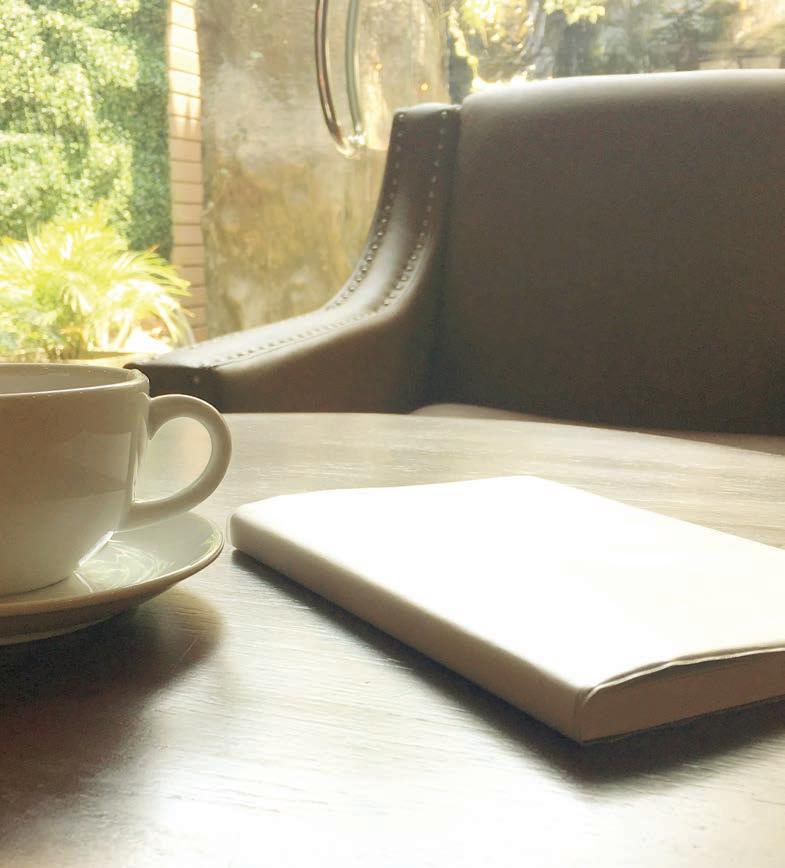








04Dear Torah Tidbits Family
Rabbi Avi Berman
08The Enduring Power of Song
Rabbi Moshe Hauer
10Aliya By Aliya Sedra Summary
Rabbi Reuven Tradburks
16Simple Belief, Genuine Belief
Rabbi Dr. Tzvi Hersh Weinreb
22Renewable Energy Rabbi Lord Jonathan Sacks zt"l
28Probing The Prophets
Rabbi Nachman Winkler
30Believers or Disbelievers?
56Haftorah Insights Rebbetzin Dr. Adina Shmidman
58Torah’s Awakening in the Land and Tu Be'shvat Rabbi Aaron Goldscheider
62How to Tell When Your Tefillin Need Adjustment Rabbi Daniel Mann
64Tu Bishevat – The New Year for Orlah and Neta Revay Rabbi Moshe Bloom
66Where Did Miriam’s Tambourine Come From? Sivan Rahav Meir
68Finding the Parents Rabbi Gideon Weitzman
70The Y- Files Weekly Comic Netanel Epstein
72היחמה לע and a Fruitful Tu b’Shvat Rebbetzin Zemira Ozarowski
74OU Parenting Column Dr. Ethan Eisen
76OU-JLIC Gavi Lazarus
78Torah 4 Teens By Teens Rabbi Michael Kahn // Shraga Fein
KIDDUSH LEVANA - SHEVAT
Last Opportunity to Say Kiddush Levana until 15 Shevat/ Sun. night Feb .5, until 18:12 pm TU BESHVAT is observed this Sunday night and Monday, Feb. 5-6
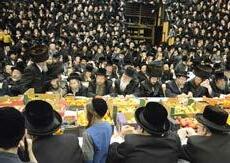
Photo By: Shlomo Gherman
I made Aliyah in 2007 with my wife. We Live in Jerusalem and have three of our 4 children living here with many grandchildren and great-grandchildren The photo was taken in the Belz synagogue in Jerusalem on Tu BShvat and shows the great significance and importance placed on this holiday by our people here in the Land of Israel.
JERUSALEM
days Wed - Shabbat Feb. 1-11 / 10-21 Shevat
OU Kashrut NCSY Jewish Action JLIC NJCD / Yachad / Our Way OU West Coast OU Press Synagogue/Community Services OU Advocacy OU Israel
MITCHEL R. AEDER, PRESIDENT OF THE ORTHODOX UNION Yehuda Neuberger, Chairman of the Board, Orthodox Union | Esther Williams, OU Israel Chair | Gary Torgow, Chair, OU Kashrus Commission

RABBI MOSHE HAUER, EXECUTIVE VICE PRESIDENT Rabbi Joshua M. Joseph, Ed.D. Executive Vice President & Chief Operating Officer | Rabbi Dr. Tzvi Hersh Weinreb, Exec. V.P. Emeritus | Shlomo Schwartz, Chief Financial Officer | Lenny Bessler, Chief Human Resources Officer
OU KOSHER: Rabbi Menachem Genack, CEO/Rabbinic Administrator OU Kosher | Rabbi Moshe Elefant, COO/Executive Rabbinic Coordinator ISRAEL: Rabbi Yissachar Dov Krakowski, Rabbinic Administrator | Rabbi Ezra Friedman, The Gustave & Carol Jacobs Center for Kashrut Education/Rabbinic Field Representative
Headquarters: 40 Rector St. 4th floor, New York, NY 10006 212-563-4000 website: www.ou.org
Editor Emeritus: Phil Chernofsky
Editor: Rabbi Aaron Goldscheider | aarong@ouisrael.org
Advertising: Ita Rochel | 02-5609125 or ttads@ouisrael.org
Website: www.torahtidbits.com
Not getting enough TTs? Too many? None at all?
Contact our DISTRIBUTION 050-577-2111 • ttdist@ouisrael.org
J. Abrams • Orthodox
STUART HERSHKOWITZ, PRESIDENT OU ISRAEL
Zvi Sand / Yitzchak Fund: Former Presidents, OU Israel

| Rabbi Emanuel Quint z”l, Senior Vice President | Prof. Meni Koslowsky, Vice President
VAAD MEMBERS:
Dr. Michael Elman | Moshe Kempinski | Sandy Kestenbaum | Norman Shmutter | Harvey Wolinetz
RABBI AVI BERMAN, EXECUTIVE DIRECTOR, OU ISRAEL
David Katz, CFO, OU Israel | Chaim Pelzner, Director of Programs, OU Israel | Rabbi Sam Shor, Director of Programs, OU Israel Center Rabbi Sholom Gold, Dean, Avrom Silver Jerusalem College for Adults
22 Keren HaYesod <> POB 37015 <> Jerusalem
91370
phone: (02) 560 9100 | fax: (02) 561-7432 email: office@ouisrael.org
website: www.ouisrael.org
Founders and initial benefactors of the OU Israel Center: George and Ilse Falk a"h
Who would have thought that a can of Heinz vegetarian baked beans could be inspiring? To me, they are a reminder of the power that one moment can have…
Growing up in a home that welcomed all types of people, kiruv was a natural path for me. When I was in Yeshivat Ohr Etzion I was taught by Rav David Yasi who had just returned from shlichut in Ohr Chaim in Toronto. His excitement and passion were palpable and ultimately lit the fire for me to actively pursue kiruv opportunities.
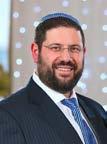
Years later, when my wife and I were approached for a shlichut position in Vancouver, British Columbia, we embraced the opportunity. Upon returning from our five-year stint in Canada where I served as the Regional Director of OU’s Northwest Region of NCSY, we eagerly shared our experiences with Rav Yasi.
However, what Rav Yasi doesn’t know is that following my role in NCSY, I accepted a leadership position at OU Israel. Together
with my team of dedicated colleagues we have been able to create meaningful programs to fortify the next generation of Am Yisrael in Eretz Yisrael. I attribute much of my growth to Rav Yasi and hope to continue to build upon the foundation he helped me create.
100 years ago the OU certified its first Kosher product - Heinz vegetarian baked beans. At the time, I would wager that OU’s leadership did not anticipate the way in which the organization would evolve. Today, OU Kosher serves as its own entity and has become the gold standard of kashrut, certifying 14,000 plants and 1.4 million products across 106 countries.
Moreover, OU Kosher provides kosher certification with a heart. All OU Kosher proceeds are invested back into the organization, supporting OU programs outside of kashrut. Over the years this aspect of OU Kosher’s business model is something which continues to inspire production facilities and store owners looking to onboard a trusted kashrut certification

while contributing to the broader needs of Klal Yisrael.


To give you an idea of how OU Kosher supports Am Yisrael, all proceeds support programs such as: Jewish educational programs (OU Women’s Initiative, OU Advocacy Center), kiruv programs (NCSY), youth programs (OU Israel Youth Centers), teens at risk (The Pearl & Harold Jacobs Zula Outreach Center), klitat aliyah (OU Israel Center Shiurim and programming, Yachad), OU-JLIC college campus initiatives and many other programs.



Reflecting on the power of that moment in 1923, I have a deeper appreciation for what unfolded just one week ago at the OU-certified Ramada Hotel in Yerushalayim. In celebration of reaching 100 years of OU Kosher, Rabbi Menachem Genack, CEO of OU Kosher and Rabbi Moshe Elephant, COO of OU Kosher, flew to Eretz Yisrael for an event that brought together 200 OU mashgichim and rabbanim involved in supporting kashrut. Of course, the full OU Israel kashrut team were there, including Rabbi Yissachar Dov Krakowski, Head

to the families of those murdered
join us in davening for a Refuah Shleima for those injured both in Neve Yaakov and Ir Davidand for the families of the murdered
of OU Israel Kashrut and Rabbi Ezra Friedman who serves as both the Director of The Gustave & Carol Jacobs Center for Kashrut Education and oversees the import of tens of thousands of products into Eretz Yisrael.
The event featured speeches by leading rabbanim, including Rav Mordechai Gross, Rav Chaim Feinstein, Rav Nissim Kaplan, Rav Yosef Tzvi Rimon, Rav Asher Weiss, Rav Shmuel Rabinovitch, Rav Yosef Efrati. Each speaker thanked the mashgichim who work tirelessly and diligently to uphold the values and standards of the OU.

The speakers also thanked Rabbi Genack and Rabbi Elephant for successfully leading such a powerful and trusted organization, highlighting the fact that OU Kosher ultimately serves as the basis for kashrut in the world. For those who are unaware of this, OU-certified ingredients make up a vast majority of the kosher-certified products in grocery stores - even those that do not have an OU certification.
When I addressed the mashgichim at
the event I tapped into the impression that Rav Yasi had on me.
I shared that when a mashgiach turns on an oven, or double checks an area of a facility, they might not appreciate the impact of their efforts in supporting the needs of Am Yisrael outside of kashrut. But by upholding the trustworthiness of OU Kosher around the country we are able to generate more business, and with each and every product, restaurant and program that utilizes OU kashrut certification, OU programs outside of kashrut benefit.
Just 100 years after vegetarian baked beans became something every Jew in North America could enjoy, I feel privileged to witness what the organization has become. Personally, I have a tremendous amount of hakarat hatov to OU Kosher, which supports 30% of OU Israel’s annual budget. That gratitude extends to our donors who further support our efforts and have a direct hand in helping OU Israel care for the needs of Am Yisrael in Eretz Yisrael.
I wish a tremendous yasher koach to the global members of OU Kosher, my OU Israel staff and mashgichim, and our donors for their continued support and dedication. May you continue to find fulfillment in all that you do.

Wishing you all an uplifting and inspiring Shabbat,
Renee
Rabbi Avi Berman Executive Director, OU Israel aberman@ouisrael.orgbut you could possibly do them. For when it comes to communications from G-d, you are unique, irreplaceable, sui generis, one of a kind.
This exchange presents a fundamental principle of the Torah: that G-d speaks to Moshe in a way that He does not, nor will He in the future ever do again with anyone else. When Moshe says that people come to him seeking G-d, what he means is: I have access to G-d. He speaks to me. (Speaking to G-d isn’t the trick; the trick is when He answers back.) Similarly, when Moshe says that he teaches G-d’s law, what he means is that G-d communicates those laws to him and to no one else.

This could very well be the prime purpose of this Yitro story. For, in the very next story, the giving of the Torah, the very same theme of Moshe’s uniqueness as the one to whom G-d speaks is central.
Moshe heard. He chose judges, with only the most difficult cases brought to him. Moshe sent Yitro home.
It takes an honest leader to accept suggestions to improve. Moshe displays his honesty and humility – if the suggestion is good, embrace it. Just as Yitro accepted the news of the Exodus and affirmed One G-d,
PROJECTS, BUILDINGS AND VILLAS

Presales and immediate occupancy.
SHAAREI CHESSED / RECHAVIA
1) Renovated 110 sqm 3 bdrms, 1st floor, succah.
2) Beautiful 3 bdrm apt + 50 sqm succah balcony, shabbat elevator, parking and view.
3) New 228 sqm duplex penthouse, 30 sqm succah balcony, shabbat elevator, parking and a view.
GERMAN COLONY
2 bdrms, 2 bathrooms, succah+ roof terrace.
OLD KATAMON
125 sqm, priv. entrance 3 exp. NIS 4,300,000

BAKA - NEWLY RENOVATED
4 bdrms, balcony, elevator, parking, storage.
sea-view

TALPIOT
Lovely 3 bdrms, 2 bathrooms, balcony, view, elevator, storage room, parking.
HAR NOF
* 5 rooms, renovated, large succah, view!
Eiferman Properties www.eifermanrealty.comLtd. JERUSALEM SALES FOR SALE - NEW LISTINGS FOR MANY MORE PROPERTIES: 02-651-4030
– is actually a reality.”
It’s very affordable – from $500,000 with just a 15% down payment, mortgages available as well as bank guarantees. Rental income often in excess of 3.5%.

02-567-0602
Keren Malki empowers families of children with special needs in Israel to choose home care. Donations are tax-approved in Israel, US and UK.
Honoring the memory of Malka Chana Roth ד”יה 1985-2001, killed in the Sbarro bombing.
to be true –
superb
Owning your own apartment does not just allow you freedom, but offers monetary savings, and an increase in your investment value. Anglo-populated, sunny Ashkelon is the answer!

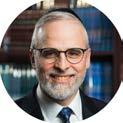
This Shabbos we celebrate Shabbat Shira, recalling the song Klal Yisrael sang after miraculously crossing the sea to freedom. Song erupts spontaneously, ala b’leebo sheyashir (Rashi, Shemos 15:1) emanating from a deepened recognition and feeling of faith (see Shir Hashirim, 4:8, tashuri meirosh amanah). And song forges a more lasting connection, as the Torah (Devarim 31:21) says about a later song, “this song shall speak as a witness, for it will not be forgotten from the mouths of their children.”
When the Iron Curtain fell, friends of ours hosted at their Seder a young family of recent immigrants whom they had befriended. The family brought their elderly grandmother who spent the bulk of the evening sitting off to the side, disengaged and rather cold to the proceedings. When they reached the closing segment of the Seder, the last series of poems that are sung with fairly universal tunes, the bubbe suddenly perked up and began to join in with the singing. The words of the Seder and its rituals could not penetrate the wall around her heart, but the songs of her youth did. This woman had been effectively separated from
the faith of her childhood for the seventy years of communism, but the song of faith endured.
This idea is conveyed by the striking contrast between our commemorations of the beginning of redemption on the first night of Pesach and its culmination on its seventh day. We begin the holiday with the Mitzvah of Hagaddah, teaching our children through words and actions the story of our redemption. We conclude the Yom Tov by singing Az Yashir, the song of redemption, the mechanism that will ensure that those lessons will be fully absorbed into our family’s very identity, never to be forgotten.
Each of us will be so much more connected to our faith and identity when we move from the words of faith to its song, by striving to fill our lives and our homes with the emotional, joyous, and uplifting expressions of our core beliefs and identity. “For it will not be forgotten from the mouths of their children.”
In memory of our Beloved Daughter and Sister 20 years later we still miss you ל"ז היח םעיל
Know that not a day goes by where you are not our first and last thought






















Paro pursues, the sea splits, the people sing. The people traveled and complained for water in Mara, for bread and meat in the Desert of Sin and for water in Refidim. Amalek attacked and was defeated.
1st aliya (13:17-14:8) G-d guides the Jews in the direction of the Sea. Moshe takes Yosef’s bones. A cloud guides them by day, fire by night. G-d instructs them to avoid the straight route to the Land of Israel for fear that return to Egypt will be too easy. Rather camp at the sea so that Paro will notice. I will harden his heart and he will pursue, in order that Egypt will know that I am G-d. Paro led his elite chariots in pursuit.
Our parsha introduces a new chapter in the history of the Jewish people: the chapter of national freedom. A cloud has hung over the people from the moment Avraham was told “your people will be afflicted in a foreign land for 400 years”. 7 complete parshas,
from the sale of Yosef til now, have told the story of that affliction.
But now with freedom comes the challenge of living. Being a free people is a wonderful concept but a hard reality. It is almost easier to live hoping for freedom than to actually be free.
Even G-d Himself is concerned that the people will balk at the uncertainties of freedom; they will wish for the comfort of the certainties of slave life. And will want to return to Egypt. Hence He diverts them to a circuitous route.
2nd aliya (14:9-14) When Paro’s army approaches, the people are afraid. They cry to G-d and say to Moshe: why did you bring us out of Egypt to die in the desert? We would have preferred to be slaves in Egypt than die in the desert. Moshe tells them not to fear, for they are about to see G-d’s redemption.
The focus of the Torah changes dramatically. There have been 4 main figures in this story: G-d, Moshe, Paro and the Jewish people. But one has been absent from most of the story: the Jewish people. We have heard precious little about the Jewish people in the entire story of the Exodus. Moshe, upon G-d’s direction, confronted Paro. Moshe received the mitzvot before the plague of the firstborn. All we hear of the Jews is that they did all that G-d commanded concerning the Pesach offering. Even the dramatic night of the Exodus, when Paro ordered them to leave, we hear only of their receipt of gold and silver and scrambling for provisions, with no time for the dough to rise.
What about joy and celebration? And of fear; concern, fear of the unknown, fear of
and our next step will be to plant a fruit tree. I never thought of myself as being the agricultural type, but the feeling of settling and planting a portion of Eretz Yisrael, has been truly euphoric. Iy”H, when we plant our tree, and eat the fruits that will grow one day, I think we will be able to truly appreciate that unique Kedusha found in the fruit of Eretz Yisrael!
change, fear of vulnerability, fear of retribution from Paro? What of their emotions, their thoughts? We know nothing of those. Until now.
All of that changes here. Now we hear of their struggles, their worries, their concerns. Because up until here, the narrative has been from G-d’s perspective – in order to teach the lesson of G-d’s Hand in the world. Now the focus shifts to the Jews. We have learnt His lessons.Now we have to live it. And that brings us fear, joy, uncertainty, disappointment, and vulnerability – all that makes people human.
To conclude, when you buy your Tu B'shvat fruit this year, don’t search for those dried apricots and banana chips imported from Turkey. Rather, head over to the fresh produce and buy yourself some nice juicy Kedusha-filled Jaffa oranges and thank Hashem for bringing you to this land in order to be able to הבוטמ עבשלו הירפמ לוכאל, imbibing that Kedusha in every bite that you take!!
3rd aliya (14:15-25) G-d instructs Moshe to raise his hand so the sea will split. And that He will harden the heart of Egypt in order that He be glorified through Paro and his entourage. And Egypt will know I am G-d. Moshe did so; the people entered the dry land in the sea with the waters as walls on both sides. The Egyptians followed; in the morning they became trapped in the sea.
The splitting of the sea renews the theme of water as a symbol of beginnings. Water featured in Creation, in Moshe’s cradle in the river and now. Beginning of the world, beginning of the Exodus and now, the beginning of Jewish national life. Jewish national life begins with the Jews stepping into the water. It is no longer just His miracles; we participate as partners in His plan. Taking that first step into the water.
4th aliya (14:26-15:26) The water returned and drowned all the Egyptians. The Jewish people saw the Egyptians dead, saw the Hand of G-d, feared G-d, believing in Him and Moshe. Moshe and the people sang “Az Yashir: I will
In the heart of calm and pastoral BAKAArab house 6 rooms, 500m + possibility of building 250m, huge garden, approx. 700m, completely renovated, underfloor heating + air conditioning, large parking, 5 bathrooms, 5 toilets, green
MENDEL 052-8980111
VERY GOOD INVEST! In Bustan Baka -


In a beautiful boutique building – Large 2 room apartment, ground floor (0 steps), elevator, balcony, parking
2450000NIS MENDEL 052-8980111
BAKA - quiet and pleasant little street5 rooms, 175m, on one level, alone upstairs, private entrance, elevator in the apartment, high ceilings
MIKAEL 052-3202488
In the heart of BAKA - on a calm and pastoral street - Spacious 5 rooms, elevator, terrace, store-room, parking, near all amenities, 5300000NIS MICHAEL 052-3202488

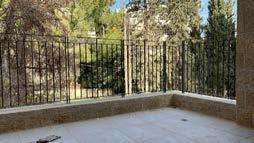


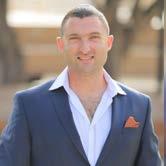


sing to G-d, my strength, my savior, my G-d. He is the One of War. Your Hand is powerful, Your Hand vanquishes enemies. Nations will fear Him. G-d will reign forever.” Miriam led the women in song. Moshe led the people to the desert to Mara. The people complained for water. G-d instructed Moshe to throw wood and sweeten the water.


Originally owned by the Interior minister of Israel
In the great Song at the Sea, we have emotion released. The people sing. Divine redemption demands a human response. In fact, when we quote the exodus from Egypt in our tefila, we inevitably mention the Shira – the story of the exodus is not over until the people sing.
Here we find joy, appreciation, elation and faith. And while the entire people sing with Moshe, the song is curiously in the first person singular: I sing, My strength (the English doesn’t note singular but in Hebrew “Azi”, my, singular, strength.) This is personal, individual – mine, not ours. We all sang the song at the sea; yet in the singular. My G-d saved me.
In fact, though I am merely speculating, this could be the source for the phrase in the Haggadah “Each person is required to view himself as leaving Egypt”. If we are exact in recounting the story in Egypt, we must note that each person, individually, personally sang the song in the singular: My G-d saved me, My G-d fought the battle. And so, if we want to tell the story of the Egypt accurately at the seder, we too must feel individually our place in that story, just as the individual Jew did at that time.
5th aliya (15:27-16:10) They traveled to the desert of Sin. They complained: oh that we would have remained in Egypt with the abundance

"
be in loving memory and
our dear parents whose yahrtzeits are in Kislev

been memorialized in a popular song, "An eternal people does not fear the long and arduous path."
Doris Weinberger a"h
ולסכ 'ד -ה"ע המלש לאקזחי תב האל הרובד
of bread and meat. The manna was provided in the morning: gather enough for a day, on Friday for 2 days. G-d appeared in a cloud.
Max Weinberger z”l
ולסכ ז"כ -ל"ז בד ןב ךלמילא
Greatly missed by their children, grandchildren and great grandchildren
Rav Aryeh and Dvora Weinberger
The series of complaints begins the sticky business of being a people. However lofty freedom be, human concerns are often more immediate. They complain for water, bread, meat and water again. Moshe is exasperated.
Bernie and Leah Weinberger


Patience is necessary for those who follow Isaac's way. But a wise woman taught us that patience is but another name for hope. That woman was Jane Austen, who put these words into the mouth of one of the characters in her great novel, Sense and Sensibility: "Know your own happiness. You want nothing but patience—or give it a more fascinating name: call it hope."
Menachem and Hannah Katten
In observance of the Shloshim of our friend
Yehuda Leib Berren z"l
Rav Menachem Weinberg will give a shiur in his memory "Heroic Joy"
Monday evening, 23 November/ 8 Kislev

7:30pm
Zoom Meeting: 853 8980 1519
Password: Yehuda
Moshe’s frustration is highlighted - in order to emphasize who the real Leader is here. The entire Exodus story is the story of Divine intervention. He freed us; Moshe merely raised his staff. He split the sea; Moshe merely raised his staff. And He cares for us; Moshe merely hit the rock with his staff. It is not the story of Moshe, the charismatic leader, taking his people to freedom. It is the story of G-d, using His trusty servant to take His people to freedom. And to care for them.
6th aliya (16:11-36) Meat will come in the evening. Each person shall gather manna daily for their needs. Some people saved for the next day; it spoiled. And some went to gather on Shabbat. G-d questioned: how long will you resist doing My commands? G-d has given you Shabbat, hence gives you double on Friday. Aharon, take a portion of manna to preserve forever. The Jewish people ate the manna for 40 years.
Shabbat precedes the giving of the Torah. The Mitzvah of Shabbat is the 4th of the Ten Com mandments. Yet, here already, before Mt. Sinai, is the notion of Shabbat. Prepare what you need on Friday. Gather double on
Friday. Do not gather on Shabbat. Because none will fall.
There is an irony in giving manna and Shabbat at the same time. 6 days you shall work. The seventh is a day of rest. But, they are being given their food falling from heaven. What work are they doing for six days?
Here, in a non-work environment, there is Shabbat. It is meant not only as a day off from the hard work of the week. It is a holy day, a rendezvous with the Shechina. The lack of work is a means to the end of spiritual focus. An intimate day with the Shechina is meaningful – whether after 6 days of work or not.
7th aliya (17:1-16) There was no water in Refidim. The people complained, as did Moshe. Moshe was instructed to hit the rock; water was produced. Amalek attacked in Refidim. Yehoshua defeated Amalek. A remembrance of this war need be recorded.
The juxtaposition of the war of Amalek with all that came before is instructive. The Divine provided us with: redemption from slavery, intervention at the sea, water, food, meat, water again. It would seem that Amalek is attacking that reality. A people
Morris Zimmerman z"l
ל"ז הקברו לדנמ םחנמ ןב השמ
א"פשת טבש י"ח רטפנ beloved elder statesman of the Teaneck community, whose kindness generosity and wisdom were sought out by so many
The Zimmerman family Nof Ayalon, Ramat Gan, Jerusalem
with a G-d that protects and provides – that is a people I attack.
The enemies of the Jewish people view us as the people of G-d. A people protected by His Hand. That provokes jealousy, resentment and denial. Of that we need no commentary.
This week’s haftorah describes the decimation of the army of the Canaanites along with its general Sisera. In response to this awesome event, Devorah offers a song of thanks. This is a parallel to the song sung by Moshe and the Israelites with the drowning of the Egyptian forces in the Red Sea.
Devorah, who was a prophetess, relays a message to Barak son of Avinoam conveying the precise instructions from Hashem: “Go and gather your men toward Mount Tabor, and take with you ten thousand men of the children of Naphtali and Zevulun. And I shall draw to you, to the brook
May the Torah learning from this issue be in loving memory of Yosef Baer
ben Shmuel Avraham z"l on his 43rd yarzheit
beloved twin brother, Michael Moshe Leib
ben Yosef Baer z"l on his 14th yarzheit
beloved cousin
Matthew S. Silverberg z"l
Meir Zalman
ben Gödel Pesach z"l on his 9th yarzheit
Malka
& Avraham Shrybmanmemory of our father, grandfather and great grandfather
Kishon, Sisera, the chieftain of Jabin’s army, with his chariots and his multitude; and I will give him into your hand.” Barak requests that Devrorah remain at his side and together head into battle.
Although Sisera was aware of the Israelites’ mobilization, Barak’s army, with the help of Heaven, utterly destroyed Sisera and his troops.
When Sisera saw that his end was near he quickly fled on foot and arrived at the tent of Yael, wife of Hever the Kenite. Yael invited the general in and offered him a place of refuge. When he fell asleep, Yael took a tent-peg and with it killed the powerful general, the dangerous enemy of the Israelite nation.
The soaring song of Devorah describing the miraculous victory is undoubtedly the highlight of this Shabbat’s magnificent haftorah!
16th of 54 sedras; 4th of 11 in Sh’mot
Written on 215.33 lines (17th)
14 parshiot; 9 open, 5 closed
116 p’sukim - rank: 23 (6th in Sh’mot) 1
681 words - rank: 19 (4th in Sh’mot)
6423 letters - rank: 18 (4th in Sh’mot)
B’SHALACH contains a single mitzvah of the 613, the prohibition of leaving one’s Shabbat boundary - T’CHUM


New Listing! On the exquisite Dubnov St. in Talbieh, private 135m cottage, totally renovated with 65m private landscaped garden, view from balconies, a real gem! MAYA - 054-6650184
Magnificent Authentic private house on a small dead end of Baka - 650m built on 3 levels with huge basement, 750m plot with wonderful landscaped garden, thoughtful layout, an abundance of light,a unique property!
DEBORAH - 054-4804767
Luxurious garden apartment on a small lane of Old Katamon, 340m built on 2 levels, 8 rooms, separate unit with separate entrance, high ceilings, full of charm, very quiet & bright, 130m private garden, top of the line finishes, close to the park
DEBORAH- 054-4804767
In a small lane of the German Colony, Garden apartment with private entrance, 250m with private garden, parking, high ceilings, in an Authentic beautiful 3 apartment building
MAYA – 054-6650184
Beautiful new penthouse in Greek Colony- 190m with 80m terraces, succah, beautiful views, 5 rooms, elevator, parking, renovated at very high standard, spacious living areas and huge kosher kitchen
MAYA – 054-6650184
On the edge of The German Colony - Unique Authentic building of 700m built on a huge plot of 1,200m - perfect for an apartment building or a tremendous private house.
DEBORAH - 054-4804767
Private small building in Baka, Shimshon St. 300m with additional building rights, huge private garden, divided into 3 units so can be private house of 3 separate apartments, very attractive price
DEBORAH - 054-4804767
On the exquisite Elcharizi St., Rechavia, new project, new 280m penthouse, 100m terraces, finishes and layout according to buyer requests!
DEBORAH - 054-4804767
Ben Maimon St. Duplex new apartment, 5 bedrooms, 4 ensuite, 4 terraces, private parking, Shabbat elevator, all renovated, 3 exposures, very sunny!!
DEBORAH-054-4804767
Mazal Tov to Ian & Rosalind Jacobs and family on the Bat Mitzvah of their granddaughter
Rachel BrachaBY RABBI DR. TZVI HERSH WEINREB OU Executive Vice President, Emeritus
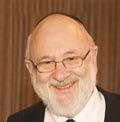
There was a time in my college days when I seriously considered majoring in philosophy. The rabbinic training program in the yeshiva that I attended did not include systematic study of the philosophy of religion. We focused instead upon the intensive study of Talmud and the Codes of Jewish Law. Our exposure to the thought of men like Maimonides was limited to his legal works, and we were never even introduced to his magisterial Guide to the Perplexed.
To rectify this void in my education, I took a few courses in the department of philosophy. They included an overview of the history of philosophy, a course on ethics, and an excellent course on the philosophy of religion. Although traditional Jewish philosophers were included in the syllabus, I certainly did not gain a thorough grounding in the philosophy of Jewish religion. Eventually, I abandoned my plan to major in philosophy because of the great gap I experienced between the religion in which I was raised and the religion I was studying.
I could not quite put my finger on what was troubling me about this discrepancy. It was when I came across a sentence in the writings of French philosopher, Blaise Pascal, that I understood my problem. He
experienced the same unease with formal philosophical studies of religion that I did. He proclaimed that his was the search for the God of Abraham, the God of Isaac, the God of Jacob, and not the God of the philosophers and scholars.
Pascal helped me to understand that my courses avoided discussing “classical theistic belief.” That is to say, the belief in a God with whom one could have a personal relationship, to whom one could pray, and with whom one could even argue. Whereas the courses I took were preoccupied with proving the existence of God, Abraham, Isaac, and Jacob, and Moses and David after them, were interacting with Him, sometimes struggling, and sometimes even holding Him to account for having abandoned them.
This week’s Torah portion, Parashat Beshalah (Exodus 13:17-17:16), contains a perfect example of religious faith as it is understood in our tradition. This example is based upon a biblical phrase which is elaborated by a Midrash and which, in turn, is further elaborated by a great Chassidic master.
The phrase appears in the verse immediately preceding the Song of the Sea, undeniably the highlight of this week’s parasha. The Lord split the sea, allowing the Israelites to escape their pursuers. Israel saw the Lord’s “wondrous power” and were inspired to join Moses in song. But first,
“they had faith in the Lord and in His servant Moses.”
 Special Projects Consultant, OU Israel Center mpersoff@ou.org
Special Projects Consultant, OU Israel Center mpersoff@ou.org









The Midrash emphasizes that all of Israel had this faith experience. “The lowly maidservant saw by the sea what even the prophet Ezekiel was never privileged to see.” (Mechilta, Shira, chapter 3) It does not take special philosophical erudition to have faith. The “lowly maidservant” exemplifies the most ordinary among us, and her example illustrates the capacity of everyone to achieve a sublime spiritual experience. Faith does not require the special religious credentials of an Ezekiel. It is available to us all.
This type of faith is known in Hebrew as emuna peshuta, simple faith.
My paternal grandfather, Rabbi Chaim Yitzchok Weinreb of blessed memory, introduced me to a book collecting the thoughts of a great Chassidic master of the early 20th century, Rabbi Israel Friedman, known as the Chortkover Rebbe. The book is entitled Ginzei Yisrael.
The Rebbe quotes the aforementioned Midrash, which implies that there are no differences between one Jew and another with regard to faith experiences. We are all capable of emuna peshuta. But, as we will read in next week’s Torah portion, there are clear distinctions between various segments of the Jewish people as they stand at Mount Sinai, at the moment of the Torah’s revelation.
Moses is instructed to stand alone, separate from his brother Aaron, who is to stand behind him. Aaron’s sons follow in a separate area further removed from the mountaintop. Behind them stand the elders, and even further behind stand the
– Jamie
Celebrity Chef
rest of the nation. How are we to explain, asks the Rebbe, the discrepancy between the rigid hierarchy dictated at matan Torah, at the time the Torah is revealed, and the inspirational moment at the splitting of the sea, at which point there were no distinctions?
The Rebbe answers that when one wishes to advance his spiritual level through Torah study and observance, there are natural differences between individuals. Some people are gifted with intellectual strengths that enable them to comprehend the depths of Torah, whereas others are more limited and can only understand Torah superficially. Some have prodigious memories so that they can remember all of Jewish law, and others can barely remember the basics. With Torah, there are individual differences. Hence the prayer that we recite at the conclusion of the Amidah: “vetein chelkeinu betoratecha, grant each of us our unique portion in the Torah.” We do not have equivalent Torah portions.
But when it comes, the Rebbe concludes, to emuna peshuta, to simple faith, there are
םתומשנ
Ernest Goldschmidt
no individual differences. Everyone is capable of sincere and genuine belief in God. It takes no special genius and no special credentials. All it requires is a religious attitude of which we are all capable.
Much has been written about the faith which even the most simpleminded person can achieve. Many of us read as children about the illiterate shepherd boy who came to the High Holiday service. He wanted to join in the community’s prayers but could not read. However, he had his shepherd’s flute with him and expressed his devotion by playing a simple melody on his instrument at the very climax of the liturgy. Whereas most of the congregation condemned his act as sacrilege, the leader of the congregation saw in an exquisite example of religious devotion, of emuna peshuta.
We possess an anecdote reported by the 16th century rabbinic sage Moshe Chagiz, who sojourned in the ancient city of Safed at the same time as the great Arizal, Rabbi Isaac Luria. A converso, an unfortunate Jew who was coerced by the Church to convert to Christianity during the terrible Inquisition in Portugal, he was reared as a Christian. He knew nothing of his Jewish religion. He fled to Safed and found refuge there. He soon was exposed to the sermons of the great rabbis who inhabited that holy city.
Rudman, Mescheloff and Manesberg families
At one of those sermons, he learned about the shewbread, the loaves of bread which were arranged upon a special table in the innermost precincts of the holy Temple in Jerusalem each week. In his ignorance, he did not know of the distinction between our ancient Temple in Jerusalem and his modest
synagogue in Safed. And so, he decided that each week he would bring two loaves of bread, two challot, to the synagogue and put them in the holy Ark together with the Torah scrolls.
Naturally, the sexton noticed these two loaves and happily took them home to his hungry family. The next morning the poor converso came to synagogue, opened the Ark, and saw that the loaves were gone. He assumed that they were miraculously taken away by an angel, or perhaps by the Holy One Himself. So he persisted in his custom of depositing two loaves bread in the Ark every week with increasing enthusiastic devotion. Of course, the sexton consistently appropriated the loaves for his own family.
Finally, the rabbi of the synagogue discovered what the converso had been doing and criticized him severely for “such nonsense.” The holy Arizal, however, saw in the converso’s weekly offering not “nonsense,” but an example of pure simple faith of the highest order. He rebuked the rabbi harshly and proclaimed to the entire community that this converso’s act of worship was cherished on High as a precious example of an act done with total religious dedication.
Nowadays, we consider ourselves too sophisticated to relinquish the God of the philosophers in favor of the God of Abraham, Isaac, and Jacob. But thereby we miss a wonderful spiritual opportunity. One does not need academic training to achieve spiritual experience, nor does one need to be a theologian to serve the Almighty. All one needs is emuna peshuta, the kind of faith that the simple maidservant of the Midrash on this week’s Torah portion modeled for us.

UNIQUE INVESTMENT CLOSE TO GERMAN
COLONY - Beautiful 4 rooms, balcony with view on the mesila park, in a process to get a new apartment and to double the investment, 3,300,000 NIS
BAKA WITH GARDEN - Close to Emek Refaim, large 4 rooms, 88m, small garden, 35m, quiet, good investment, 3,300,000 NIS
PENTHOUSE IN GERMAN COLONYUnique penthouse, 3 rooms, 80m, in a luxury bulding with Shabbat elevator, terrace, 50m with panoramic view, storage, parking, 4,200,000 NIS
UNIQUE HOUSE IN OLD KATAMON - Great location, Beautiful house on a plot of a dunam, huge garden, Arabic style, quiet, 2 parkings spots, rare!
28, Kovshei Katamon Street, Jerusalem Tel: 02.5633008 - www.ben-zimra.com


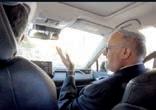
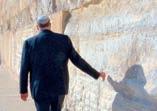

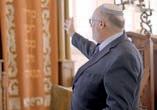
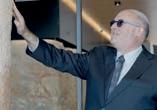







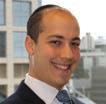



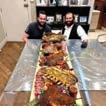
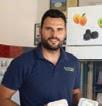

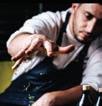



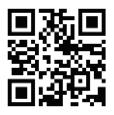
The first translation of the Torah into another language – Greek – took place in around the second century BCE, in Egypt during the reign of Ptolemy II. It is known as the Septuagint, in Hebrew HaShivim, because it was done by a team of seventy scholars. The Talmud, however, says that at various points the Sages at work on the project deliberately mistranslated certain texts because they believed that a literal translation would simply be unintelligible to a Greek readership. One of these texts was the phrase, “On the seventh day God finished all the work He had made.” Instead, the translators wrote, “On the sixth day God finished.”1
What was it that they thought the Greeks would not understand? How did the idea that God made the universe in six days
1 Megillah 9a.make more sense than that He did so in seven? It seems puzzling, yet the answer is simple. The Greeks could not understand the seventh day, Shabbat, as itself part of the work of Creation. What is creative about resting? What do we achieve by not making, not working, not inventing? The idea seems to make no sense at all.
Indeed, we have the independent testimony of the Greek writers of that period, that one of the things they ridiculed in Judaism was Shabbat. One day in seven Jews do not work, they said, because they are lazy. The idea that the day itself might have independent value was apparently beyond their comprehension. Oddly enough, within a very short period of time, the empire of Alexander the Great began to crumble, just as had the earlier city state of Athens that gave rise to some of the greatest thinkers and writers in history. Civilisations, like individuals, can suffer from burnout. It’s what happens when you don’t have a day of rest written into your schedule. As Ahad HaAm said, “More than the Jewish people has kept Shabbat, Shabbat has kept the Jewish people.” Rest one day in seven and you won’t burn out.
Shabbat, which we encounter for the first time in this parsha, is one of the greatest institutions the world has ever known. It

changed the way the world thought about time. Prior to Judaism, people measured time either by the sun – the solar calendar of 365 days aligning us with the seasons – or by the moon, that is, by months (“month” comes from the word “moon”) of roughly thirty days. The idea of the seven-day week – which has no counterpart in nature – was born in the Torah and spread throughout the world via Christianity and Islam, both of which borrowed it from Judaism, marking the difference simply by having it on a different day. We have years because of the sun, months because of the moon, and weeks because of the Jews.
What Shabbat did and still does is to create space within our lives and within society as a whole in which we are truly free. Free from the pressures of work; free from the demands of ruthless employers; free from the siren calls of a consumer society urging us to spend our way to happiness; free to be ourselves in the company of those we love. Somehow this one day has renewed its meaning in generation after generation, despite the most profound economic and industrial change. In Moses’ day it meant freedom from slavery to Pharaoh. In the nineteenth and early twentieth century it meant freedom from sweatshop working conditions of long hours for little pay. In ours, it means freedom from emails, smartphones, and the demands of 24/7 availability.
What our parsha tells us is that Shabbat was among the first commands the Israelites received on leaving Egypt. Having complained about the lack of food, God told them that He would send them manna from heaven, but they were not to gather it

For Sale in The Village, Zayit, Eftat
Stunning 210m 8 room cottage, 2 private parking spots, central A/C.
4,800,000 NIS
For Sale in Dagan, Efrat
Stunning 8 room cottage, middle unit. 3 floors, 230m. 5,250,000 NIS
For Sale in Gefen, Efrat
Beautiful 5 room duplex garden
2,850,000 NIS
For Sale in Dagan, Efrat

5 room garden apt. 120 meters
2,990,000 NIS

For Sale in Olive Project, Zayit, Efrat
Gorgeous 4 room apt. 120m.
2,850,000 NIS
For sale in Zayit, Efrat
6 room duplex apt. 2,850,000 NIS
Contact Gabi for more info
0524588716
Gabi- 0524588716


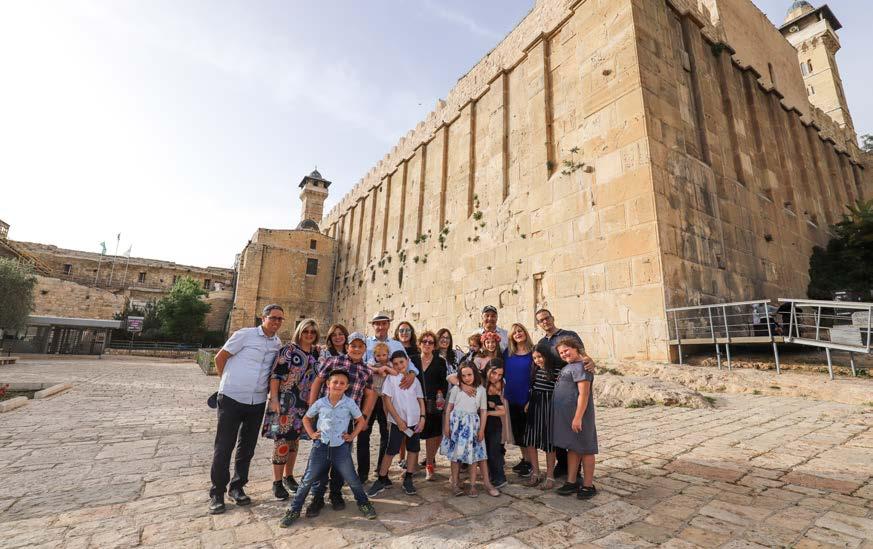
www.lovingtheholyland.com

Not only was Shabbat culturally unprecedented. Conceptually, it was so as well. Throughout history people have dreamed of an ideal world. We call such visions, utopias, from the Greek ou meaning “no” and topos meaning “place.” They are called that because no such dream has ever come true, except in one instance, namely Shabbat. Shabbat is “utopia now,” because on it we create, for twenty-five hours a week, a world in which there are no hierarchies, no employers and employees, no buyers and sellers, no inequalities of wealth or power, no production, no traffic, no din of the factory or clamor of the marketplace. It is “the still point of the turning world,”
a pause between symphonic movements, a break between the chapters of our days, an equivalent in time of the open countryside between towns where you can feel the breeze and hear the song of birds. Shabbat is utopia, not as it will be at the end of time but rather, as we rehearse for it now in the
God wanted the Israelites to begin their one-day-in-seven rehearsal of freedom almost as soon as they left Egypt, because real freedom, of the seven-days-in-seven kind, takes time, centuries, millennia. The Torah regards slavery as wrong, but it did not abolish it immediately because people were not yet ready for this. Neither Britain nor America abolished it until the nineteenth century, and even then not without a struggle. Yet the outcome was inevitable once Shabbat had been set in motion, because slaves who know freedom one day in seven will eventually rise against their chains.
The human spirit needs time to breathe, to inhale, to grow. The first rule in time management is to distinguish between matters that are important, and those that are merely urgent. Under pressure, the things that are important but not urgent tend to get crowded out. Yet these are often what matter most to our happiness and sense of a life well lived. Shabbat is time dedicated to the things that are important but not urgent: family, friends, community, a sense of sanctity, prayer in which we thank God for the good things in our life, and Torah reading in which we retell the long, dramatic story of our people and our journey. Shabbat is when we celebrate shalom bayit – the peace that comes from love
and lives in the home blessed by the Shechinah, the presence of God you can almost feel in the candlelight, the wine, and the special bread. This is a beauty created not by Michelangelo or Leonardo but by each of us: a serene island of time in the midst of the often-raging sea of a restless world.
I once took part, together with the Dalai Lama, in a seminar (organised by the Elijah Institute) in Amritsar, Northern India, the sacred city of the Sikhs. In the course of the talks, delivered to an audience of two thousand Sikh students, one of the Sikh leaders turned to the students and said: “What we need is what the Jews have: Shabbat!” Just imagine, he said, a day dedicated every week to family and home and relationships. He could see its beauty. We can live its reality.
The ancient Greeks could not understand how a day of rest could be part of Creation. Yet it is so, for without rest for the body, peace for the mind, silence for the soul, and a renewal of our bonds of identity and love, the creative process eventually withers and dies. It suffers entropy, the principle that all systems lose energy over time. The Jewish people did not lose energy over time, and remains as vital and creative as it ever was. The reason is Shabbat: humanity’s greatest source of renewable energy, the day that gives us the strength to keep on creating.
These weekly teachings from Rabbi Sacks zt”l are part of his ‘Covenant & Conversation’ series on the weekly Torah teaching. With thanks to the Schimmel Family for their generous sponsorship, dedicated in loving memory of Harry (Chaim) Schimmel. Visit www.RabbiSacks.org for more.

Jerusalem Real Estate is My Business
Eta: 054-723-3863 Rachel: 052-546-6425
Amazing stand alone homes in OLD KATAMON, TALBIYA, BAKA, GERMAN COLONY
Allenby Complex. Across from BAKA. 160 sqm penthouse quiet with views. 4 bedrooms & 2.5 bathrooms. Shabbat elevator, sukka terrace from living room plus roof top terrace 2 parking & storage. 6,400,000 NIS
Yemin Moshe beautiful property over 300 sqm. 2 private entrances (complete separate unit over 90 sqm). large garden. Close to parking & gorgeous architectural design newly renovated. Call for more info
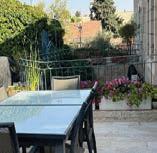
In the heart of BAKA enclosed in a magical courtyard: 3 bedrooms 2 full bathrooms one flight up. Beautiful spacious sukka terrace facing open gardens
Completely renovated with architectual design & high level finishes. 6,250,000 NIS
Penthouse near BAKA. 154 sqm on one floor with 4 bedrooms and 2 full bathrooms. Shabbat elevator, 2 underground parking and 3 storage units!!! 25 sqm Sukka terrace off living room plus large roof top terrace. 6,250,000 NIS
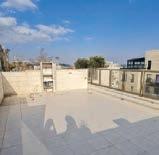
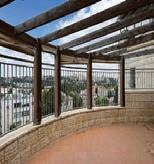

Eta Morris Realty, Ltd.

etamorrisrealestate@gmail.com
Eta: 054-723-3863 · Rachel: 052-546-6425
etamorrisrealty.co.il
israelrescue.org/jlmmarathon23





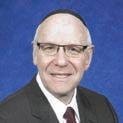
Upon reading this morning’s haftarah one can easily see the obvious connection that it has to our parasha of B’shalach, for, although the weekly portion is replete with historical events and divine miracles, there is no question that its highlight is found in Hashem’s final confrontation with the oppressive Egyptian tyranny. With this single, wondrous event, G-d’s miraculous splitting of Yam Suf’s waters (and the resultant destruction of the enemy’s military), the many years of oppressive Egyptian domination and enslavement were put to an end. It was no wonder, then, that Moshe and B’nai Yisrael reacted by bursting forth in a song of victory to Hashem, the Az Yashir, hence, we mark Shabbat Shirah.
In a similar – if not exact - way, our haftarah focuses upon the great miracle performed by G-d at Nachal Kishon (near Har Tavor) during the leadership of Devorah Haneviah. The Canaanite king, Yavin, together with
his general, Sisera, cruelly controlled the Israelite population in northern Israel for some twenty years. Hashem responded to the desperate cries of Israel and defeated the repressive power in a battle at Nachal Kishon. Our Rabbis point out (Pesachim 118b) that the victory over the Canaanites mirrored, in many ways, the victory over the Egyptians. As the Egyptians drowned in the waters of Yam Suf, so were the Canaanites swept away by the waters of Nachal Kishon. And, while the chariots of Egypt were mired in the muck of the sea bed so were the Canaanite chariots stuck in the mud of the overflowing river. As a result, the Egyptians lost 600 iron chariots in the Reed Sea; as a result, the Canaanites lost 900 chariots at Har Tavor. And, as Moshe and B’nai Yisrael sang a song of praise to Hashem at Yam Suf, so Devorah and the Israelites sang their praises to G-d after His victory over the oppressive Canaanites.
Beyond these similarities, it is also
BY RABBI CHANOCH YERES R av, Beit Knesset Beit Yisrael, Yemin Moshe“And Bnei Yisrael went up armed out of the land of Egypt. And Moshe took the bones of Yosef with him.” (13:18-19)
The pasuk tells us that the Israelites came out armed from Egypt. What were these weapons that they had and where did they get them from?
The Mayenah Shel Torah (Rabbi Zusha Friedman) brings us two explanations.
One idea is that Pharoah himself provided the weapons to the Israelites. He did this in order not to reveal the secret of the strength of the Israelites, that they were victorious because of miracles and wonders. Other nations would see these arms that were in their possession and understand that it was a conventional armed victory.
Another idea is that the weapons the pasuk is referring to were the remains of Yosef that they took with them from Egypt. The merit of a Tzaddik, like Yosef, serves as a shield for his people, as it says in the Talmud Chullin 8b that “ the righteous are even greater in death than they were in life.”
Shabbat Shalominteresting to note that there are but four women in all of Tanach who were referred to as “prophetess” (with one of them being a false prophetess). The first time that a woman prophetess is mentioned occurs is in this morning’s parasha where Miriam is referred to as a “neviah” and the second time in Tanach where we find mention of a prophetess is in today’s haftarah about Devorah who was both a shofettet (the only woman judge in Sefer Shoftim), “judge” and the only judge to be a prophet as well.
All of this is quite fascinating. But there is a very important contrast between these two parallel episodes – a contrast that is important to note. The newly freed slaves at Yam Suf were incapable of facing the Egyptians. Their perception of their oppressors as “masters”, or as being “invincible”, weakened any resolve the Israelites may have had to oppose them and forced Moshe to silence their frightened cries by reassuring them with the words: “Hashem yilachem lachem” (“Hashem will fight for you…”). D’vora, however, was told by G-d that the nation had to confront their enemy, so she turns to her general, Barak, and directs him to gather an army. Additionally, she turns to all of the tribes to send men into battle fight their enemy. The recently enslaved tribes who had no land of their own could barely mount any opposition, but a nation living upon her own land, a land promised to them since the days of their patriarchs, was expected to raise an army and, together with Hashem’s help, to battle for victory.
The essence of victory is Man’s efforts and Hashem’s support. Hashem expected that of D’vora and Barak.
Hashem expects no less today!
Flying Soon?
Travel with Confidence
1UniTravel - Medical Insurance
at great prices Choose from multiple options
1unitravel.brokersnexus.com
1UniSim - Sims for USA and Worldwide
Starting at $40 sales@1unisim.com
Call 077-400-3199 or USA 718-715-0001
Great Investment! 2 rooms, mirpeset & underground parking in new building under construction in a great location. Starting at 1.89m NIS/ 3 & 4 rooms also available.
Baka very close to Emek Refaim, 4 rooms, 82m in a tama 38 building. Elevator, mirpest & storage. Will be ready in 4 months. Amazing price of 2.99m shekel
For rent in Old Katamon - 4 rooms, renovated, ground floor, high ceilings, small garden, parking. 9000 shekel per month

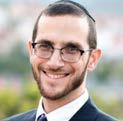
In Parshat Beshalach we are informed of what transpired as the geula, (exodus) from Mitzrayim unfolds. Upon a closer look at the pesukim however, there seems to be a conflicting account of the reaction of the people. We will examine several of these seemingly conflicting portrayals, and provide a solution to resolve the inconsistency based on a thought expressed by Rav Eliyahu Shlesinger in his sefer Eleh Hadevarim.
Fright or Might?
First we are told:
Bnei Yisrael were armed when they went up out of Egypt. (Shemot 13:18).
The gemara (Yerushalmi Shabbat 6:4) defines the term “chamushim” as “armed”. They left Egypt armed and fully determined to fight for their rights until the end. If that is the case, then they would be unlikely to retreat at the first appearance of the enemy. Why then would Hashem have to take them in a round-about way to avoid the nation from desiring to return to Egypt? Were they ready to fight, or were they fearful?
Second we are told:
13:18).
Rashi explains that the people were led via the desert out of fear.
Yet, later we are told
did
lead them [by] way of the land of the Philistines for it was near, because God said, Lest the people reconsider when they see war and return to Egypt. (Shemot 13:17).
The Torah specifically indicates that the nation was taken out of Egypt in a roundabout way out of fear that if they would take a road that would be too close to Egypt, when confronted by the Egyptian’s they may fear for their lives and determine to retreat back to Egypt.
Yet, in the very next pasuk we are informed that:
14:8).
Again, were they mighty or fearful?
When confronted with the enemy at one end and the sea at the other, the nation turns to God as is stated:
cried out to Hashem. (Shemot 14:10).
The Michilta uses this pasuk to highlight the nation’s belief in God. They followed in their forefather’s footsteps and turned to Hashem in prayer. This clearly portrays their
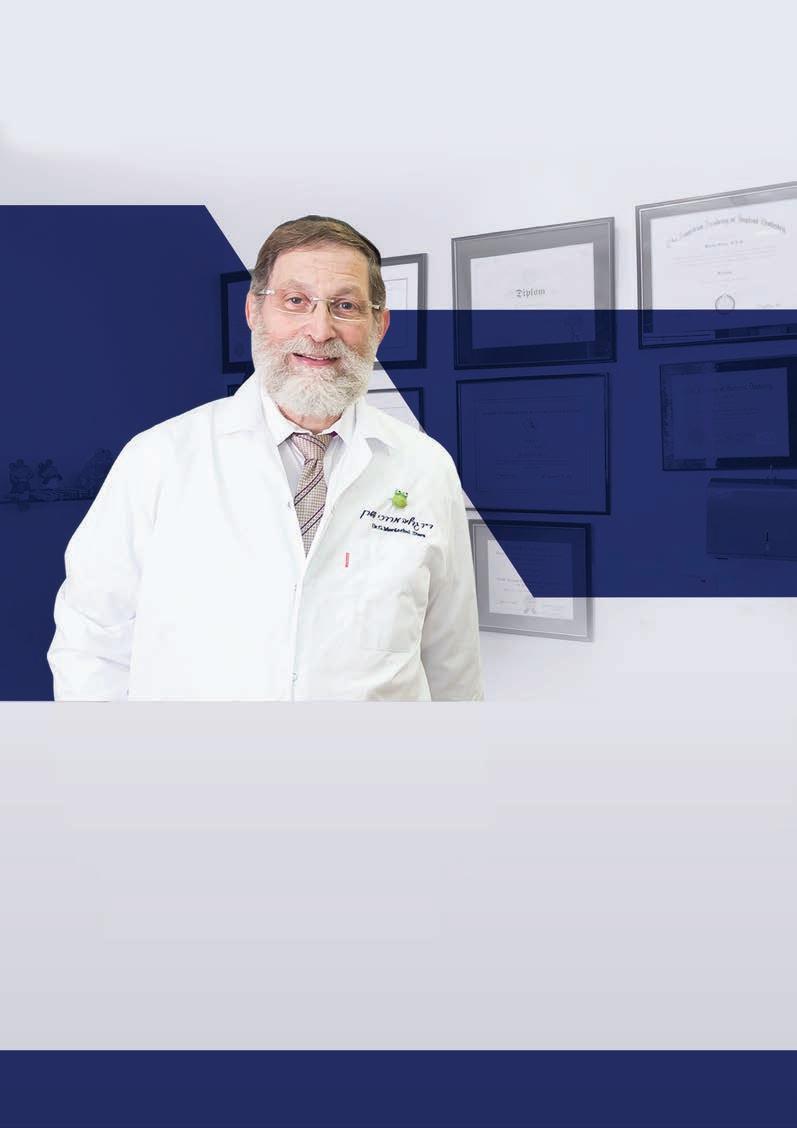
faith and belief in the Almighty.
Yet, in the following pasuk, the people complain:

They said to Moshe, is it because there are no graves in Egypt that you have taken us to die in the desert? What is this that you have done to us to take us out of Egypt? (Shemot 14:11).
In the previous pasuk, the nation prayed to God. Immediately thereafter they blame Moshe for risking their lives by seeking to lead them to freedom.
Suf, as the Torah states: "הב ונימאיו ה תא םעה ואריו ודבע השמבו. The skeptics finally learned to fear God. Yet, the true believers were the ones to express gratitude out of love, inspiration and appreciation. Those that spontaneously sang joyously were the believers. ינבו השמ רישי זא לארשי. Those individuals are labeled as ‘Bnei Yisrael”.

In a deeply powerful scene, Moshe Rabbeinu is found with his hands held high on top of the mountain praying for the people gripped in a raging battle with Amalek below. Ahron and Chur stood on either side of Moshe Rabbeinu holding his hands aloft (Shemot 17;10). Rashi teaches that Chur was the son of Moshe’s sister, Miriam. What more do we know about Chur? What is the symbolism of his joining with Ahron to support the hands of Moshe Rabbeinu?
After reviewing the pesukim cited above, it seems a bit confusing. Was the nation confident and ready to fight, or did they fear for their lives? Did the nation have faith and belief in God, or did they doubt and question God’s ability and Moshe’s guidance?
Rav Shlesinger distinguishes between two distinct groups of people. If you look at the pesukim cited above, you will notice that the words “Bnei Yisrael” and “Am” are highlighted. There were actually two groups of people in the nation. One group, referred to as “Bnei Yisrael”, had unequivocal faith. They prepared to leave Egypt, were ready to fight and prayed to God for salvation. The other group is referred to by the term “Am”. They lacked faith, feared the enemy and condemned Moshe’s placing their lives in danger.
Rabbi Roberts in Through the Prism of Torah explains that Ahron and Chur personified contrasting character traits. Ahron was a peacemaker, he constantly looked for ways to create harmony among his people. Indeed, he was ready to compromise his own values to achieve this goal, as we see in the story of the sin of the golden calf. Chur,
The “Am” learned to fear God after witnessing and experiencing the miracles at Yam
on the other hand, was a person who stood strong in his values, unbending and resolute in his beliefs. Chazal teach that Chur tried to challenge the people when they wanted to build the calf and they subsequently killed him. Chur, a descendent of Yehudah, was a person who was inflexible and strong like a lion. Truly, a combination of both qualities is necessary. In interpersonal relationships it is wise to follow Ahron’s path, to compromise and make peace whenever possible. However, in the service of Hashem and reinforcing kevod shamayim, one needs to follow Chur’s example and be resolute in his values. These two special people joined Moshe Rabbeinu to activate the merits of these approaches as he implored Hashem to have mercy on His people and vanquish Amalek, physically and spiritually.
Later in the parsha when the people complain they are referred to as the Am - ונוליו םעה. This continues throughout the journey in the desert. In particular when the nation transgresses with the golden calf – they are referred to as “Am”.תדרל השמ ששוב יכ םעה אריו – The nation saw that Moshe was delayed from descending from the mountain. (Shemot 32:1). Hashem refers to them as השק םע ףרוע – a stiff necked nation.
The Torah does not randomly switch the title it attributes to the nation. The term Bnei Yisrael is used to depict believers. The term Am is used to describe disbelievers. The Jewish nation is tied to its ancestors – and its faith is its secret to survival. We are the children of Yisrael- Yaakov. He faced and overcame many challenges. May we strengthen our commitment, belief and faith and be counted among those who affiliate themselves not just as being part of the Jewish nation -the “Am”, but of Bnei Yisrael!
In a unique Old Arab style building - Spacious 110sqm, 4 room apartment with Sukah balcony, Shabbat elevator, parking & large separate storage room. lots of character, excellent condition, central A/C Truly one of a kind! 5,280,000nis
For Sale – Old Katamon, Negba st., 1st floor, Arab house, 4 rooms, (total about 160m), high standard of renovation, Sukkah porch, 2 full bathrooms + guest bathroom,






















Parashat Beshalach opens with the Exodus of the Jewish people from Egyptian tyranny. The Torah inserts an important detail, “Vayikach Moshe et atzmot Yosef imo ki hashbe’a hishbi’a et Benei Yisrael lemor pakod yifkod Elokim etchem veha’alitem et atzmotai mizeh itchem – And Moshe took Yosef’s remains with him since Yosef had bound the children of Israel with an oath, saying, “When Hashem will remember you [to take you out of Egypt] you must bring my remains out of here with you.”” Why does the Torah share this now and not in the previous parashah when Am Yisrael was leaving Mitzrayim?

Rav Wolfson in Emunat Itecha, shares the significance of this unusual placement. Chazal teach us that at keriyat Yam Suf, “hayam ra’ah vayanos – the sea saw and fled.” (Tehillim 114;3) What caused the sea to flee at that moment? The sea saw the bones of Yosef Hatzadik, the one who “vayanas,” who fled from sin (falling prey to the machinations of Potiphar’s wife). Rav Dov Yaffe in Leavdecha B’emet, further expounds that
Faculty, OU Israel Center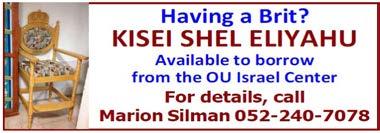
Yosef Hatzadik conquered his base nature, hence the sea went against its natural course and split for Am Yisrael. The Torah is sharing the refuah before the makah. We are clued into the Jews’ salvation before the crisis; it was Yosef’s merit that led to deliverance from their Egyptian pursuers.
What’s more, on the words, “Veha’alitem et atzmotai mizeh itchem., Rashi adds an additional detail based on the michilta. Yosef’s directive to take his remains out of Mitzrayim included taking the remains of his brothers. Now, this begs the question, why doesn’t the Torah share this information outright? Why suffice with a hint?
To answer, Rav Bloch in Shiurei Da’at, teaches a fundamental approach to learning Tanach. He explains that what we find written in Torah informs the world’s creation and development, moving us from the beginning of time until the end of time. Each passuk is connected to spiritual manifestations Above that directly impacts our physical world. Our limited perspective leads us to think we know what has significance and importance. Often, we err; only Hashem knows what constitutes the ‘pulse’ of the universe and what is worthy to be written. Yosef Hatzadik was the one who demanded that his remains
were to be brought to Eretz Yisrael. This then, most powerfully impacts the cosmos, hence it is mentioned; the brothers’ bones are not mentioned, it is a detail that holds lesser significance in the grand scheme. This vort from the Telshe Rosh Yeshiva encourages us to look deeply at every passuk to find its eternal message. Never look at any part of Tanach as extraneous or inconsequential.





Rav Soloveitchik in Yemei Zikaron highlights Moshe Rabbeinu’s role in taking Yosef’s remains out of Mitzrayim. It is no coincidence that Moshe Rabbeinu, from the tribe of Levi, was the one who remembered Yosef’s promise. Levi was the brother who masterminded the original plot against Yosef Hatzadik. The Torah is underscoring the scope of the brothers’ teshuvah. Here, a descendant of Levi grasped the extent of Yosef Hatzadik’s greatness and realized that without Yosef, Am Yisrael could not leave Mitzrayim.
Moreover, teaches Rav Kasba in Vayomer Yehudah, the image of Yosef was integral to the Jewish people’s loyalty to Hashem. Yosef Hatzadik was the model of one who successfully mastered his yetzer hara. Therefore, the Torah only mentions his remains as they symbolized the strength and conviction to live with the highest moral standard.
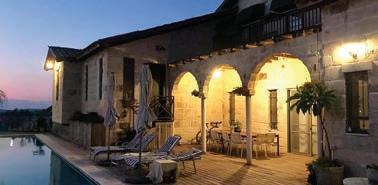
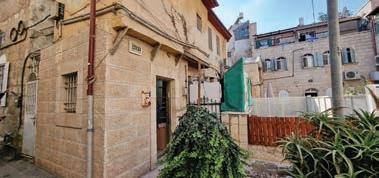
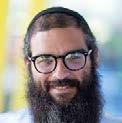
The great tzadik Rebbi Chaim haGadol (d. 1845) of Mogador (Essaouira), Morocco, was a link in the illustrious, holy chain of chachamim in the Pinto Family. He was talmid chacham who rose for Tikun Chatzot in the middle of each night, and then learned Torah until dawn. He was renowned for his love and sacrifice for others, he maintained an ongoing chavrusashaft with Eliyahu haNavi, and was the head of a family that spawned generations of spiritual leaders. His grandson, the holy Rebbi Chaim haKatan of Casablanca (d. 1937), was named haKatan / ‘the Small’ in order to distinguish him from his grandfather, haGadol / ‘the Great’. Yet, he inherited the family legacy of kedushah, chesed, love of Am Yisrael — and the ability to give miraculous blessings.
A local fisherman in Mogador struggling with his livelihood once came to Rebbi Chaim haKatan to pour out his heart, share his burden and receive the tzaadik’s blessing. Rebbi Chaim listened quietly to the man’s pain. He then removed his shoes and handed them to the fisherman, saying, “When you go to the dock, place these shoes in the water. May Hashem bless you with parnassah b’shefa!”
The fisherman left with Rebbe Chaim’s shoes in his hands, went to the shore and
submerged them in the water. Within seconds, they were surrounded by swarms of fish, well beyond any amount that he could net and carry home.
That evening, the fisherman went to the tzaddik with a basket full of fish as a gift. Filled with awe, he recounted the events of the day. Rebbi Chaim refused to accept any gifts: “Baruch Hashem! My friend, these fish are yours. I had nothing to do with this shefa — they are for you.”
Our sedra recounts how, arriving thirsty at the bitter waters of Marah, Hashem instructs Moshe to take a piece of wood and throw it in the water. Miraculously, it turns the bitterness into sweetness.
“So he cried out to Hashem, and Hashem showed him a piece of wood; he threw it into the water and the water became sweet. There Hashem made for them a fixed rule; there they were put to the test.” (15:25)
Midrash Tanchuma (24) offers several opinions regarding the nature of the wood utilized by Moshe. The suggestions include the wood of the aravah or willow tree, ivy, olive or cedar wood, or the root of a fig or pomegranate tree. The consensus among Sages is that the wood was itself bitter. Moshe thought or assumed that Hashem would tell him to sweeten the waters with something sweet, like honey or pressed
On Thursday morning just before 09:00 A.M., two men were injured in a collision between an electric scooter and a bicycle on HaMa’ayan street in Ramat Gan. Panicked bystanders alerted emergency services.
United Hatzalah volunteer EMT Yosef Akler, a sales agent by profession, was at work in the vicinity when an alert went off on his communications device. Excusing himself, Yosef dashed to his ambucycle and zipped to the scene with lights and sirens on.

Arriving first at the scene in just under 2 minutes, the volunteer strategically parked his ambucycle to block incoming traffic and cordon off spectators, creating a safe space for emergency responders to do their jobs.
The EMT began by assessing the condition of the two patients. According to onlookers, the two vehicles had collided frontally. The cyclist, in his early 50s, was agitated and a little woozy, after falling from his bike and hitting his head without a helmet on. He was in moderate condition. Yosef checked him for signs of internal bleeding, calming and reassuring his patient as he applied a cervical collar in order to limit the effects of the trauma. The rider of the scooter, in his early 20s, had fallen on his right shoulder and was lightly injured. Together with medical personnel who arrived on the scene, the volunteer immobilized his shoulder.
A few minutes later, an ambulance arrived at the scene and together with the ambulance crew, Yosef loaded the cyclist onto a backboard in order to further immobilize his spine. The medical personnel at the scene then placed him in the ambulance to be transported to the nearest hospital for further treatment. Another ambulance also transported the rider of the scooter to the hospital.
“It’s very rewarding to see the sense of relief on the face of the patients when you’re the first emergency responder to arrive at the scene,” said Yosef after the incident. “I have been volunteering with United Hatzalah for seven years because it’s important for me to help people whenever possible. United Hatzalah has given me the tools and the knowledge to do just that.”
• Curtains & draperies
• Designer curtains
• Venetian & Woven wood blinds

• Blackout, Vertical, Roller, Roman & Pleated shades

www.ashleywilde.co.il


:םילשוריב תוריכמו קוויש להנמ
:דיקפתה תושירד
םייתנש תוחפל- םוחתב םדוק ןויסינ ·
,תיקוויש היגטרטסא תיינבב חכומ ןויסינ ·
םלוהינו םיביצקת תנכה
,רצקה חווטל םידעי רידגהל תלוכי ·
ךוראו ינוניב
טנירפו לטיגידב םינייפמק לוהינב ןויסינ ·
ןורתי- ביטיאירקו קווישו גותימב ןויסינ ·
ץחל תחת הדובעו תומישמ יובירל תלוכי ·
םידעיו
ידרחהו יתדה רוביצה לש הנבהו תורכה ·
,יביטרסא יפוא לעב ·
םילועמ שונא יסחיו יגוציי הארמ
םא תפש תמרב תילגנאו תירבע ·
,בשחמ תונכותב תואצמתה ·
Microsoft תוברל
CRM תוכרעמ ,PPC, SEO ב תיסיסב
figs. Instead, the Ribbono Shel Olam leveled with Moshe:
, “Moshe, My ways are not like man’s ways, and now you must learn this fact. The Torah therefore says, ץֵע ׳ה ּוהֵרֹוּיַו, “Hashem showed him a tree.” The Midrash points out that in actuality,
אָּלֶא , “The pasuk does not just mean vayir’ehu, ‘and Hashem showed him,’ but also vayorehu, ויָכָרְדִּב ּוהָרֹוהַו, ‘and Hashem taught him (His Divine ways)….’”
Rebbi Shimon ben Gamliel, too, tells us that the episode at Marah accentuates the supernatural ways of Hashem. Man improves the taste of something bitter with something sweet, but Hakadosh Baruch Hu performs a miracle and improves the taste of something bitter by adding something bitter.
A grandson of the saintly Baba Sali, zy’a, Rav Avraham Yehudayoff is the Rosh Kollel haRem”a, named for Rebbi Masoud Abuchatzeira, the Baba Sali’s father. He says in today’s generation young people consider the miracles of tzadikim to be unreal, however, in earlier generations, people knew how to accept the words of a tzaddik with pure emunah. And because of that emunah, they witnessed miracles.”
Perhaps this is the yesod, the ‘foundation’ for understanding the extraordinary episode of the fisherman, above. Sod Hashem li-reyav, ‘The Divine secret is (in relation) to the one who is in awe of Hashem.’ Beyond whatever hidden mystical intentions Rebbe Chaim haKatan may have had in asking that his shoes be placed in the water, it was just a תינוימד הלועפ, a symbolic or ‘representative action’ used to channel the Divine blessings, and the
miracle was really revealed in the merit of the fisherman’s pure, simple faith: “I had nothing to do with this shefa — the fish are for you.”
“They had faith in Hashem and in Moshe, His servant.” (14:31)
Whether we find ourselves, metaphorically, at the Yam Suf, Mara, Mogador — or anywhere else on our derech — the blessings of the true tzadikim await us. Shabbos Shirah invites us to renew our emunah in the fact that Hashem is just waiting to reveal that all we experience as bitter may be sweetened. May our baskets overflow with the ‘fish’ of miraculous blessings; may we ‘learn’ to recognize Hashem’s mysterious ways, and sing to Him songs of awesome praise.
This week: Funds urgently needed for false teeth for elderly, sick man (the portion not covered by Kupat Cholim)
• Checks: Make out to “Yesh Ezra” Send to: Yesh Ezra, POB 36156, Romema, Jerusalem
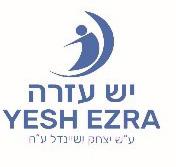
• Bank Transfer: Bank Mercantile (17), Branch 642, A/C 79747843, Yesh Ezra
• Credit card by phone: Sara at 077-820-0196 (Sun-Thu. 10:00am-3:00pm)
• Website: www.yeshezra.org Click on “Donate Now”
Inquiries: Menachem Persoff 050-570-1067
menpmp@gmail.com




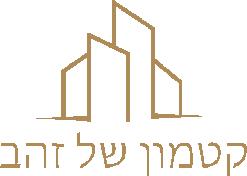
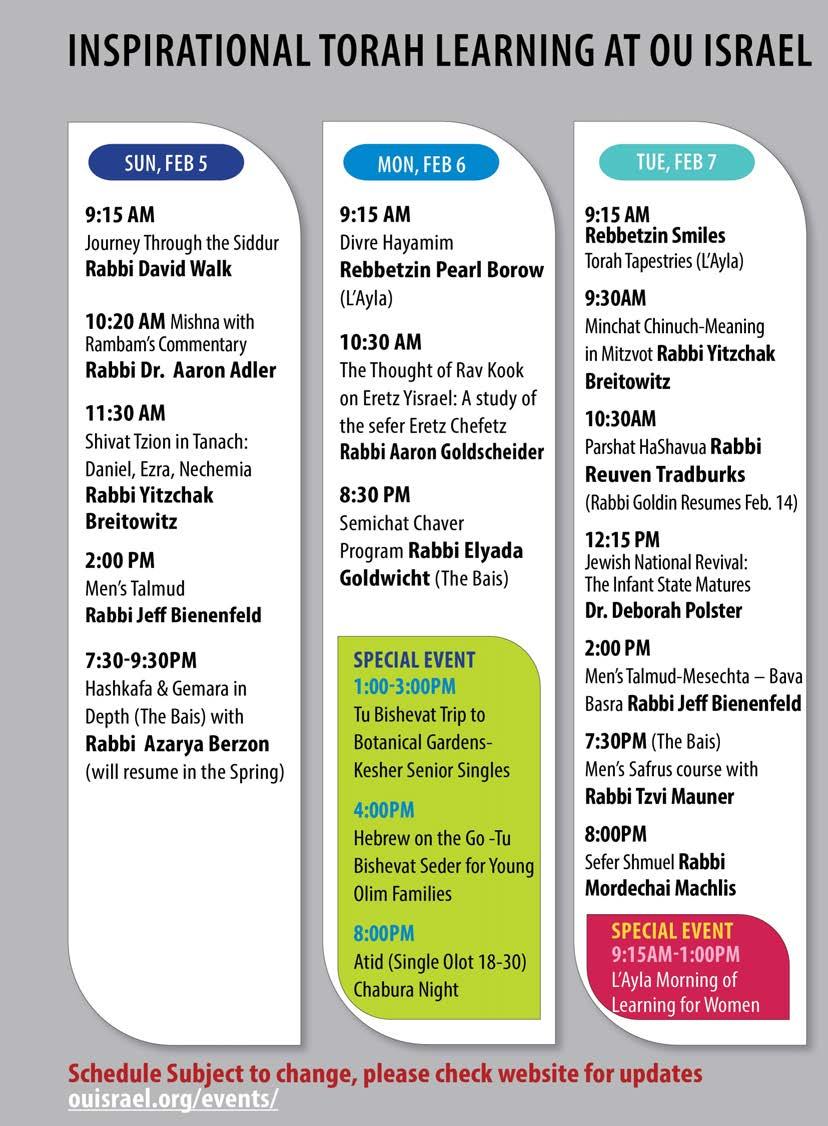
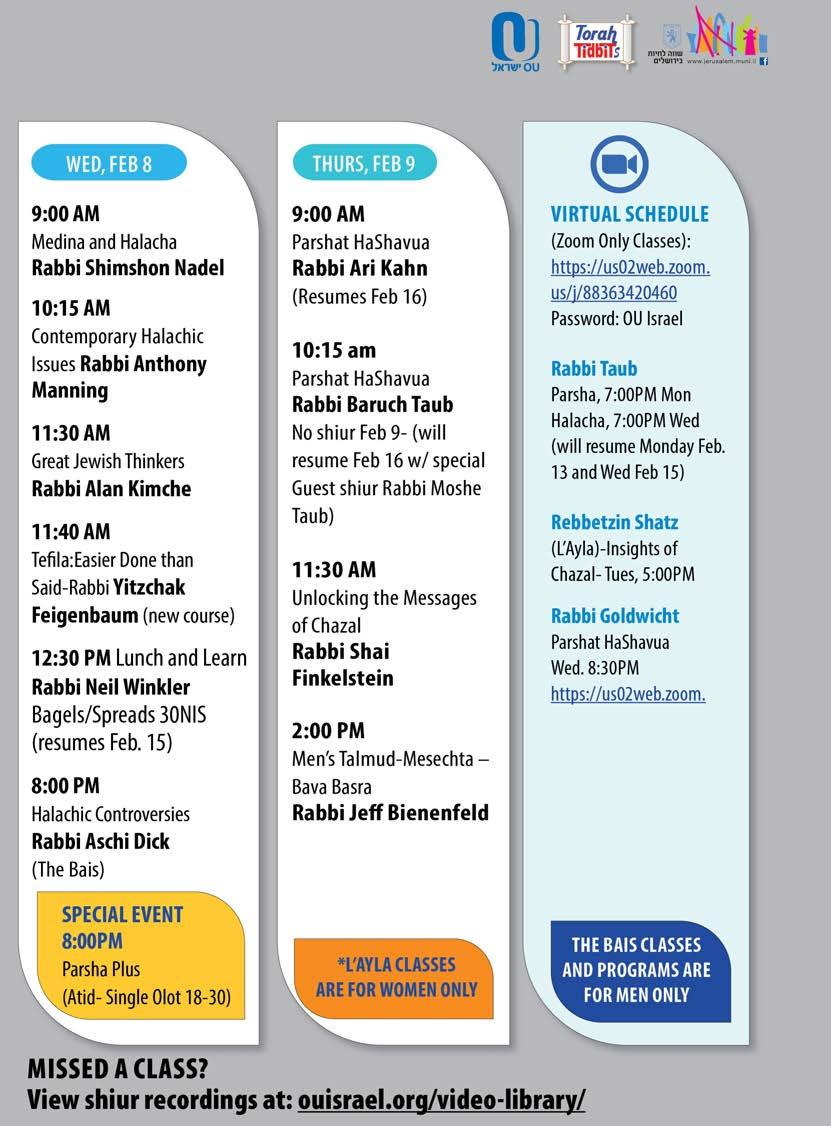





Monday, January 30th - Rebbetzin Pearl Borow’s shiur is sponsored by Meryl Goldwag in memory of her father, Chazkel ben Meir z”l, whose yahrzeit is 3 Shevat - May his neshama have an aliyah
Wednesday, February 1st - Rabbi Manning’s shiur is sponsored by Shlomo & Michele Choina - they live in the United States and listen to his class every week. They are here now visiting and wanted to show their appreciation to him.
Tuesday, February 7 (16 Shvat) - All learning today is sponsored by Rabbi Yehoshua & Yocheved Bienenfeld, l’ilui nishmas Yocheved’s father, ל”ז ףסוי םולש ןב המלש ןמלק “Kelly” Winkler Rabbi Goldscheider’s shiur has been sponsored for the 2023 Academic Year
ל’’ז המלש ןב בוט םשו ה’’ע םהרבא תב םירמ תמשנ וליעל Rebbetzin Shira Smiles shiur is sponsored for the 2023 academic year by Dr. & Mrs. Menachem Marcus in memory of their parents, Rose & Dr. Emanuel Marcus z”l -
ל”ז סוקרמ השמ ןב יכדרמו ריאמ ףסוי תב לזייר Rosi and Ernest Strauss z”l -
ל”ז סוארטש דוד ןב לאינדו םהרבא תב דומיל
Rabbi Breitowitz’s Tuesday Shiur - Minchat Chinuch is sponsored for the academic year 2023 by Rabbi Refoel & Sharon Auman in memory of their parents Edith & Reiner Auman z”l
ד”יה לאפר תב ה”ע רתסאו ל”ז קודצ ןב הנוי and their son Rabbi Shmuel Eliyahu Auman z”l
י”נ לאפר ברה ןב ל”ז והילא לאומש ברה
Rabbi Goldin’s shiur is sponsored for the 2023 academic year by Dr. & Mrs. Menachem Marcus in memory of beloved aunts Irma Haas a”h and Hilde Myer a”h
Rabbi Manning’s shiur has been sponsored for the 2023 academic year
ל’’ז ןמלק ןב גילזו ה’’ע תידנרב תב הנרב תמשנ יוליעל
Rabbi Taub’s weekly Thursday Parshat HaShavua Shiur is sponsored by The Jewish Legacy Foundation







Director Hadassah Jacob 052-384-7230


Monday Evenings 7:00 - 9:00pm
WOMEN'S WRITING WORKSHOP AT THE OU ISRAEL CENTER
Monday mornings 10.30-12.30
For more details, call Ruth 02-628-7359 or Judy 054-569-0410

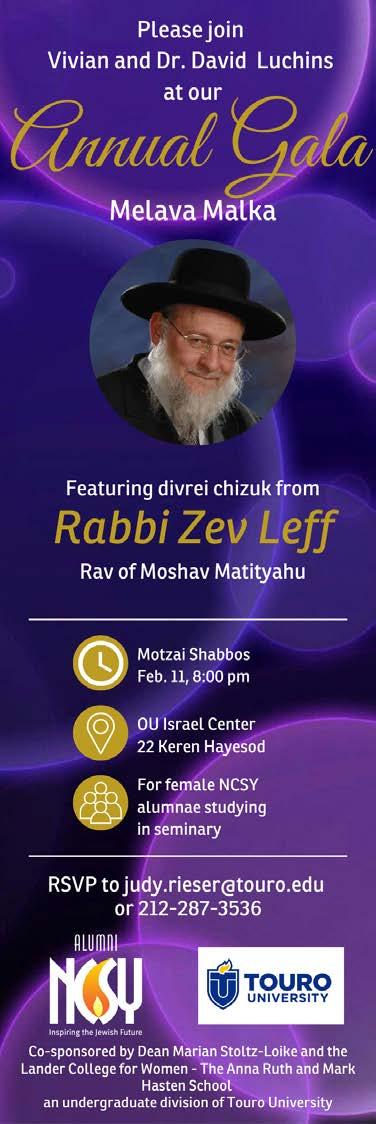



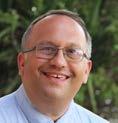
Our Sedra, Parshat Beshalach, recalls the incredible miracle of Kriat Yam Suf, the Splitting of the Sea.
Kriat Yam Suf, and the spontaneous Song of Praise and appreciation that the Jewish people sang is such an important moment in Jewish history, that we recall it each and every morning as part of the verses that precede Tefilat Shacharit. There is one particular verse that we recite each morning that I find to be exceptionally inspirational.
“Uvnei Yisrael halchu bayabasha b’toch haYam”- “And the Jewish People walked on dry land within the Sea...” The simple interpretation of this verse is that as the Jewish People traversed the Sea of Reeds, a miracle occurred allowing the sea to part and literally the Jewish people walked on dry land. There are several rabbinic teachings in both the Midrash and the Talmud that depict the scene as the sea actually parting into twelve sections, and each tribe walking on its own path amid the waters. But the great Chasidic Master, the Noam Elimelech, Rebbi Elimelech of Lijensk zy’a , offered a unique interpretation of our pasuk.
“The verse speaks of the idea that ‘...the children of Israel walked on dry land amidst the sea..’ that is that G-d gifted them with such revelation that even after they had passed through the sea, and were now on dry land, their faith and ability to experience G-d’s presence, was exactly
as they felt while in the midst of the sea, in the midst of the miracle...
The Noam Elimelech’s explains that Am Yisrael was so impacted by the miracle of Kriat Yam Suf, that even after the miracle had ceased, the revelation stayed with them, the miracle remained with them.
Similarly, the Birkat Avraham, the Slonimer Rebbe zy’a, that the word b’toch (within) is equal in gematria to the word chatach (one who divides or distributes), a reference to the fact that Hashem Yitbarach is indeed the source of parnasa- sustenance and stability.
A person might often feel that he or she is drowning in debt or stress, that the waters of trouble are surrounding them on all sides, and they might not see or intuit any natural way out from under the pending waves that they fear will engulf them. In such circumstances, says the Rebbe, a Jew must always recall and be strengthened by remembering the great miracle at the Sea, and realize that Hakadosh Baruch Hu is the One who will bring them out of the depths.
The same is true, the Rebbe continues, in spiritual matters. At times, one feels as if they are walking on dry land, they feel spiritually uninspired- dried out, within the sea of Kedusha. In such instances, a person must recognize that even those spiritual dry spells are also from the Ribono Shel Olam, and thus be strengthened to persevere, and continue to cross the proverbial
sea, to immerse themselves in the sea of Kedusha, even when they might feel at that moment as if they are walking along on dry land. Hashem is there with us, even when we might be struggling.
May we all merit to embrace and be strengthened by these beautiful teachings from the Noam Elimelech and the Birkat Avraham of Slonim zy’a, and be able to reflect on the miracle of Kriat Yam Suf as a source of eternal chizuk, so that we may have the fortitude to face life’s challenges, with the faith and confidence that Hashem is indeed there together with us, every step of the way.
A small Sefer Torah with its own Aron Kodesh is available to shiva houses or for any other necessary occasion on a temporary free-loan basis.
If needed call Uri Hirsch 0545513173

Orit Madar,Adv.
Family Law and Mediation Divorce, Child support, Custody Inheritance & Wills
Yariv Madar, Adv.

Bodily Injuries, Medical Malpractice Civil Litigation
10 Hillel St., Jerusalem | 36 Dam hamkabim st., Modiin 02-6255592, 050-3202909
Madar@netvision.net.il
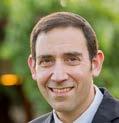
Keriyat Yam Suf was a dazzling spectacle, unlike any of the previous miracles. Quieting a riotous ocean and paving a smooth marine route for three million people was incomprehensible to the human imagination. Hashem’s presence was palpable, and as we witnessed this wonder unfold, our national mood was transformed.
Throughout the process of Yetziat Mitzrayim, we had been inactive and were even skeptical of Moshe and his promises. Initially, we had embraced him, believed in his redemptive proclamations, and rallied to his revolution. Unfortunately, Moshe’s preliminary efforts at liberation were met by Pharo with stiff resistance, scorn and retaliatory policies. Suffering an intensified work-load, we gradually abandoned trust in this “false prophet” and, for most of the year-long process of liberation, sat by idly, as Moshe dueled with Pharo.
As redemption neared, our spirit
awakened, and we actively contributed to the redemption. In the final days leading up to the actual exodus we defied Egyptian traditions by sacrificing animals, which were the object of pagan worship. This courageous defiance of Egyptian culture sparked the final stages of our emancipation. We finally played a small part, in our own redemption. We were now invested in our own freedom.
However, we were still dubious. Rushed out of Egypt without time to even bake our bread, we were more confused than convinced. Everything happened so quickly, it was difficult to determine if this was real or just a mirage. Would we return to Egypt after a three-day religious festival or was this the first leg on our journey home to Israel? It was a strange turn of events and the entire first week felt surreal.
A week later, standing at the shore of the ocean, even the non-believers were convinced. The stilling of a roaring ocean and the stiffening of the rushing waves provided incontrovertible proof that Hashem had descended into history to redeem his enslaved children. Viewing the bodies of the fearsome Egyptians washing up on the seashore provided closure, finality, and faith.
At this point our belief in Hashem and in His redemption was so deep-rooted and pervasive that we instinctively burst into song. Finally,
we believed with a full heart, and finally, we found the voice to articulate that belief. Observing Hashem descend into our world and wreck Nature was too much to ignore.
The midrash narrates a very different timeline and progression for the miracle of splitting of the ocean. Hashem did not suddenly intervene in Nature to invert the natural system. Rather, this miracle was pre-programmed into Nature at the dawn of creation. During creation, when Hashem fashioned the seas, he programmed the waters of the Yam Suf to spontaneously split and harden as the Jews neared. He arranged for the chemical structure of the water molecules to solidify 2448 years into history. Though it appeared dramatic and breathtaking, it was all planned and engineered ahead of time.

The Rambam applies the midrash’s comments about Keriyat Yam Suf to all major miracles. For example, Hashem didn’t meddle with the orbit of the sun to grant Yehoshua more time to rout his enemies. Instead, Hashem pre-choreographed the sun’s orbit to naturally halt precisely on the day that Yehoshua required additional time for his military exercise. Though miracles appear to be divine interventions, they are, in truth, divine pre-calculations stitched into the fabric of Nature. They were conceived and implemented before history began and well before the actual miracles occurred. Miracles are baked into Nature.
For some, this description of miracles reduces their drama and their spiritual force. After all, the radical image of Hashem swooping in and overwhelming the natural order is captivating. However, though
sudden interventions may seem more appealing, ironically, the Rambam’s model of a miracle distills several important themes of Jewish redemption.
The gemara in Shabbat chronicles a poor man who lost his wife and was left attending to his nursing infant. Miraculously, he began to lactate and to nurse the baby. An amora, Rav Yosef (who was blind), assumed that this person was distinguished, based on his benefitting from divine intervention. Abaye, his student, retorted that, evidently, this person was not as esteemed as his teacher had asserted. Had this father been more admired by Hashem he would not have experienced this anatomical deformity. Had he been important enough, perhaps Hashem would have spared his wife, or supplied female volunteers to nurse his infant. Ad hoc and inelegant solutions didn’t speak well of this man’s character. Important needs should be planned ahead of time, rather than solved in a last minute and graceless fashion.

Miracles of Jewish redemption weren’t supplied as last minute solutions, but were prefabricated from the beginning of time. Jewish history is important enough to merit divine attention, even as the entire cosmos was being formed. Hashem’s

preprogramming of Jewish miracles demonstrates His great love for us. Preprogrammed miracles may feel less wondrous, but they demonstrate Hashem’s great love for our people. We are not a last-minute agenda for Hashem, but a high priority of His.
Redemption is Inevitable
Prior to creation, reality was still inchoate and dark, as the “spirit of G- d” hovered above the chaos. Chazal decode this spirit as a Messianic potential which was created prior to the formation of our universe. As redemption is the inevitable terminus of history, it was pre established before the world took shape. Before creation was launched the conclusion of history was already conceived.
Slotting miracles into Nature at the inception of history also reflects redemption’s inevitability. Redemption may take a while, but it is inexorable. Its trajectory is woven into the foundation of our world and marches on to the drumbeat of Nature.
Astonishingly, at the sea we began to sing about a future we hadn’t yet been informed of. We sang about the mountain of Jewish heritage or ךתלחנ רה and about a Mikdash we would one day construct on its peak תלעפ שדקמ ’ה. Watching Nature cooperate with Redemption assured us of Redemption’s unavoidability, and suddenly the overall trajectory of Jewish history became obvious: we would enter the Land of God and construct a place for His presence. Though we were hundreds of years away from these visions and we hadn’t been informed of these dreams, everything seemed perfectly clear. Pre-ordained miracles provided confidence in the certainty of redemption.
Finally, the Rambam’s version of miracles assumes symmetry between Jewish redemption and Nature. The synchronicity between Nature and Jewish history underscores that Redemption is not a parochial Jewish experience, but has broader and more universal connotations. As Redemption affects all reality, Nature isn’t sidelined, but is a willing accomplice in the process.
Our redemption launches a period of universal welfare in which an entire global population perceives Hashem through our own religious experience. Humanity gathers in Yerushalayim to encounter Hashem and to herald the Jews, whose faith and courage outlasted history. Weaving redemptive miracles into the texture of Nature demonstrates the broader impact of Jewish redemption. For Nature to serve humanity it must collaborate in Redemption.
Not only is human history advanced by redemption, but the condition of Nature herself is enhanced. By designating homo sapiens as the pinnacle of creation, Hashem hitched the state of His Natural world to the religious condition of Man. When human behavior aligns with divine will Nature thrives. If human will deviates from divine will, Nature deteriorates. When human behavior plunged into a moral abyss, Nature collapsed, the world was flooded and had to be rebooted through Noach.
Nature has a vested interest in Jewish redemption, which rejuvenates the natural order and restores the pristine state of Hashem’s creation. Miracles of Jewish history do not ransack Nature, but serve Nature. Jewish History and Nature live in perfect harmony. Redemption changes everything.
Walking down King George St. in Jerusalem and want a cold bottle of water? Come help yourself to a bottle at 52 King George. In loving memory of Yoni’s wife Tziporah a"h, a true Eishes Chayil, always full of chessed, kindness and laughter, and brought life and strength to so many people, that she touched! She was like Aron, who loved peace and pursued peace.
Yoni thanks Hashem for having the opportunity of having Tziporah in his life, to learn of her caring, patience and happiness, to overcome her challenges. May Tziporah's Neshama be a light onto the world, in a time of darkness, and may her Neshama shine to Gan Eden. Yoni misses Tziporah with tears in his eyes, as Hashem gave him a gift, a crown jewel, now he returns her to Hashem. With thanks and Toda. Love, Yoni
To help refill the supplysend tax deductible donations for Be’er Tziporah a"h Bottled Water Gemach to Chabad of RechaviaRabbi Yisroel Goldberg email
Rabbi@JerusalemChabad.org 02 800-1717
www.JerusalermChabad.org/DonateShekels



In describing the benevolence of Hashem, Devorah uses the expression,
there they will recount the righteous deeds of Hashem, the righteous deeds for His open cities of Israel. The general understanding of the pasuk is that Hashem was particularly kind to those in the most vulnerable positions. The people in the unwalled cities were sitting targets for the enemies’ fire. They were attacked mercilessly and only because of Hashem’s miracles were they able to withstand the enemy attack.
The Gemara (Pesachim 87b) interprets this pasuk in a homiletic fashion. The kindness of Hashem is evident in His dispersing of the Jewish people, לֵאָרְׂשִיְּב ֹו נֹוזְרִּפ. By spreading the Jewish people across the world, there are always Jews ready and able to help their brethren in distress. This is true not only in times of distress but also in times of joy and celebration. Knowing that you are sharing positive experiences with
other Jews though divided across oceans strengthens our people is reassuring.
These words resonate for me personally as we celebrate the conclusion of Sifrei Neviim as part of the second cycle of Torat Imecha Nach Yomi. Participants across the world are connecting daily through the words of our sacred texts. Knowing that there are women in France, Germany, Australia, South Africa, Canada, America and tens of other countries listening to the same holy words binds us together. There they will recount the righteous deeds of Hashem… learning together and growing, we give praise to Hashem for all His gifts, including spreading us throughout the world so we can study and disseminate His holy Torah. We speak the same language, the language of the Torah, regardless of our native tongue. May the Torah’s words continue to inspire and uplift us no matter where in the world we find ourselves.

























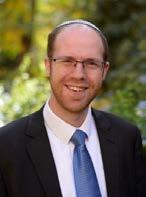








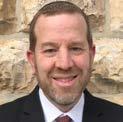
“The Torah of Eretz Yisrael continues to develop and be awakened along with the renewal of the building [of the Land], [and along with its] practical initiatives, and together with recognizing our own true essence.” (Eretz Chefetz 2:2)
A story is told of Rabbi Menachem Mendel of Kotzk celebrating B’shvat with his chassidim.
Sitting around the festive table laden with fruits, the Rebbe began to lavishly praise the Land of Israel, describing its beauty and splendor. As night began to fall there was a knock at the door. The Rebbe of Ger, Yitzchak Meir, had come from Warsaw to celebrate what was left of the day with the Kotzker Rebbe. The Rebbe asked his esteemed friend Rabbi Yitzchak Meir to say words of Torah. Rabbi Yitzchak Meir hesitated to teach in the presence of the Rebbe, but everyone urged him to give them pleasure by teaching Torah in honor of the day.

Rabbi Yitzchak Meir began to speak about the holiday and developed a complex interpretation of the Talmud’s discussion of the New Year of Trees.
The Kotzker Rebbe was displeased because Rabbi Yitzchak Meir had diverted everyone’s attention from the Land of Israel, and he said to him, “Do you know, Itche Meir, that in the Land of Israel you wouldn’t say Torah teachings like
“Why not?” asked Rabbi Itche Meir, surprised.
“Because,” said Rabbi Mendel, “in the Land of Israel the New Year of the Trees is just that - a day to observe the laws about the fruit trees that apply in the Holy Land , and it doesn’t require any complicated interpretations” (A Person Is Like a Tree, Buxbaum, pp. 230-231).
The above anecdote accentuates the notion that living in the Land has an impact on the way its laws are studied. For example, for many centuries these laws could only be analyzed via theoretical study in exile. Returning to the Land compels one to address the law and implementation along practical concerns and based on tangible realities.
The aforementioned teaching from Rav Kook comes to life through the lens of one of the most remarkable Chassidic leaders
of the past century. An ardent lover of the Land of Israel. A builder in the Land. A man of unshakable faith: The Klausenberger Rebbe. Rabbi Yekusiel Yehuda Halberstam was a heroic figure and a holy man.
After the destruction of European Jewry in the Holocaust, and his own personal experience of destruction, the loss of his wife and eleven children, the Rebbe’s greatest desire was to restore and to rebuild. He made a personal pledge during those days of horror that his efforts to reconstruct the nation will be focused on one place: the Land of Israel.

Although many survivors after the war viewed Immigration to America as their ticket to a better future, the Rebbe was quick to remind them, the Land of Israel is the Jewish people’s true home (The Klausenberger Rebbe, Lifshitz, p.162).
The Rebbe made a promise to himself during the Holocaust, in the midst of the suffering, that if he merited to survive the Nazi horrors, he would move to Eretz Yisrael (Ibid., p. 266).

On his first trip to Eretz Yisrael in 1954, he first stopped in London en route to the Holy Land. On Shabbos afternoon a large group of people came to be present at this auspicious gathering. The Rebbe gave a stirring speech, addressing the topic of educating the children in Torah, yiras shamayim, and the holiness of Eretz Yisrael. He denounced the fact that religious Jewry was largely uninvolved in the rebuilding of the Holy Land (Ibid. 281).
The Rebbe would finally make aliyah on the 19th of Kislev (1959). In the years that followed, he would celebrate the 19th of Kislev as the day of his ascent to the Holy Land.
February 4
Between 20:00-22:00





all


He would liken it to another major event that also occurred that same date. “Just like Rebbe Shneur Zalman of Liadi, the first Rebbe of Lubavitch, celebrated his release from prison on this day, I celebrate the day I left America and was saved from its depraved society” (Ibid., p. 336).
Not only did the Rebbe build the city of Sanz in Netanya, he promised himself that he would build a hospital. The vision of building a hospital
came to him during the Holocaust, when he self-treated a Nazi- inflicted gunshot wound on his arm with a leaf and a branch. He said at that time, that if he got out of that inferno alive, he would build a hospital in Eretz Yisrael where every patient would be treated with dignity and where all doctors and nurses would believe in God and know that they were fulfilling the greatest mitzvah in the Torah.

Rav Kook teaches that the entire Jewish people have a single soul. He made an acute observation regarding this point when commenting on the experience of the Jewish people at Mount Sinai. When God gave the Torah to the Jewish people, the term vayichan, “and he encamped,” in the singular was used to describe the masses of people standing around the mountain. Rashi commented that the Torah’s strange usage of the singular verb was used because the Jews were like a single entity, “like a single person with a single heart.”
However, when discussing the unity of the Egyptians in hot pursuit of the Children of Israel on the shores of the Red Sea, Rashi used a similar term, yet it was reversed to, “with a single heart like a single person.”
What accounts for the difference?
Why are the Egyptians called “like a single heart in a single person,” whereas the Jews are described as, “like a single person with a single heart?”
Rav Kook explained that the unity of the Egyptians flowed merely from the fact that they had unity of purpose. They all had the same goal - to recapture their Jewish slaves. They were first and foremost “of one heart,” be-lev echad. They had a common goal, and as a result they were unified as a single unit.
This was not the case for the Children of Israel. The Jewish people have an inherent unity which exists regardless of personal beliefs and interests. We are a family, and a family has unbreakable ties. No matter where its members may be or what they may do, we are above all else, a “single unit,” k’ish echad. (The Light That Unites Haggadah, pp. 129-130)

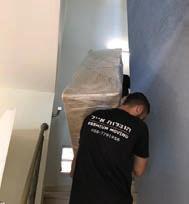



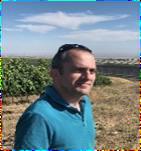




[Periodically, we re-issue our discussion on the proper position of tefillin shel rosh (last time, seven years ago). Many people do not realize that tefillin extending too far forward is a far more severe problem than being slightly off center. In Living the Halachic Process, I:G-1, we develop the halacha that the end of the tefillin must not go beyond the roots of the hair of the hairline.
Upon visiting different shuls, from various elements of society, it pains me to see great numbers of fine Jews who are definitely donning their tefillin wrong and many others about whom it is hard to tell, especially when they have receding hairlines. Since even some talmidei chachamim get it wrong, I assume that knowing how to apply the halacha to one’s head is a big problem. We will focus here on tricks to figure this out.]
Question: How can one tell when his tefillin shel rosh needs adjustment?
RAV DANIEL MANN
Answer: Firstly, an adult who has not adjusted his tefillin shel rosh’s knot in several years almost certainly needs an adjustment. Tefillin straps stretch slowly as we apply pressure to them (some more than others) when fastening the tefillin on our head. If one’s hairline has not receded, he can easily check.
Now, a little review of the anatomy of a normal human head. The skull is highest towards the back of the head; it then gradually slopes down. Near the front of the head, the slope increases, and then turns into a “cliff” (i.e., the forehead). The hairline ends at the end of the gradual or the midst of the increased slope. No hair (except eyebrows) is rooted in the forehead.
Based on the above, the following are signs of misplaced tefillin. If the end of the tefillin looks like it is “hanging off a cliff,” it is certainly much too far forward, as a line drawn down from the end of the tefillin would hit the forehead or even the nose. Because of the increased slope, there may be a little space between the bottom of the tefillin and the head. However, if there is too much room (i.e., a finger fits in comfortably), it is very likely not in the right place.
Another sign is the tefillin’s angle. The angle is determined primarily by where the tefillin are fastened to the head by the straps – at the back of the tefillin. Generally, tefillin in the right place will be upright with a slight downward slant. If the tefillin has a serious downward-facing angle, it is generally

The Orthodox Union - via its website - fields questions of all types in areas of kashrut, Jewish law and values. Some of them are answered by Eretz Hemdah, the Institute for Advanced Jewish Studies, Jerusalem, headed by Rav Yosef Carmel and Rav Moshe Ehrenreich, founded by HaRav Shaul Yisraeli zt”l, to prepare rabbanim and dayanim to serve the National Religious community in Israel and abroad. Ask the Rabbi is a joint venture of the OU, Yerushalayim Network, Eretz Hemdah... and OU Israel’s Torah Tidbits. (unless one has a rounder head than most) too far forward, so that its rear is where its forward part should be (on the steeper slope). Thus the tefillin’s front will be too far forward, unless the tefillin are very small.


A final sign is the kippa. With average size kippot and tefillin, there should be little or no room between the two. One with a particularly large kippa or who wears it on the top of the head (as opposed to part top/part back) will have to move the kippa back.
When I look around many of the shuls I regularly daven in or visit, I see many too many people with apparent (or definite) problems in this regard. Among the older generation, I would estimate that the problems are in well above 50% of the people. As I HATE correcting people (and most hate being corrected), I am torn as to when the rectifiable problem is clear enough to halachically/morally require me to do the uncomfortable. The following limud zechut decreases the problem. Most
people put the tefillin at a certain position and push it forward in the process of fastening. Thus, some of those who keep the tefillin too far forward had it in the right place for a few moments after the beracha (so that it is not l’vatala) before the fastening was complete, and thereby may have fulfilled the mitzva for that short time.
More people should learn how to shorten the circumference of the head strap, which is necessary for the tefillin to stay in the right place. You are invited to visit me or ask a sofer. It may be easier to Google search: “youtube tefillin head adjust.” Then, you can help yourself and your friends.
On HaPalmach - great 4 room apartment, 92m plus large garden in use, exclusive. Asking 4.95 million NIS



In a good area in the Moshava2 apartments (can be connected), 1st floor, 170m, renovated, Sukkah porch, parking Palmach - 4 rooms, beautiful, 105m, porch, 2 parking spots, machsan, asking 6.1million NIS
Smadar 050-3114040 // 02-642-4329
smadi_bida@walla.co.il
The Mishnah calls 15 Shevat (Tu Bishevat) the new year for trees, which is halachically significant for orlah, neta revay, terumot and ma’aserot.
Chazal note that trees store energy for several months. Effectively, in the first months of the year trees are influenced by energy they received from the previous year. Thus, their fruits also belong to the previous year. Chazal determined that by 15 Shevat, the trees already received the majority of their energy from the current year. For this reason, from this point on the fruits belong to the current year.
The halachot that pertain to orlah and neta revay this year (as opposed to terumot and ma’aserot; more on that next week) are identical to other years.
Chanatah and Tu Bishevat
Fruit that reaches chanatah before 15 Shevat halachically belongs to the previous year, while fruit that reaches this stage after 15 Shevat belongs to the current year.
Most posekim define chanatah as the stage after petals fall and the new fruit begins
BY RABBI MOSHE BLOOM en.toraland.org.il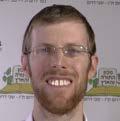
to form. It generally takes 3–8 months for fruit to ripen after this time. That is, a fruit that began to develop last summer (5782) and ripened this winter (5783) halachically belongs to 5782. Even a fruit that reached chanatah in Cheshvan and ripened in Adar belongs to last year (5782) and not to the current year (5783).
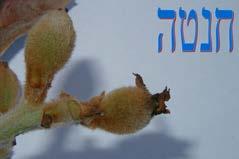

It is possible that fruit harvested after 15 Shevat belongs to the previous year, since it began to form before 15 Shevat. Practically speaking, most fruits do not begin to develop at this stage, besides lemons, almonds, loquats, and apricots. For such trees there may be fruits from different years hanging on the same tree.
For trees planted in 5780 (until 15 Av), 5780 is first orlah year, 5781 its second year, and 5782 its third. Fruits growing on such trees until 15 Shevat 5783 belong to 5782 and are orlah and forbidden to eat. Only fruits that reach chanatah after 15 Shevat 5783 are not orlah. All fruits that reach chanatah from 15 Shevat 5783–15 Shevat 5784 are fourth-year fruit, neta revay. Fruits that reach chanatah after 15 Shevat 5784 are fifth-year fruit and obligated in terumot and ma’aserot.
Whether you are transferring your career to Israel, looking to pivot into a new field, or at the very beginning of your career, Nefesh B’Nefesh’s UpGrade is here to help!BY SIVAN RAHAV-MEIR
At a time when we are flooded with gloomy prognostications, the fol lowing episode in this week’s Torah portion can plant hope inside us and give us strength.
After the splitting of the Red Sea, the nation erupted in song, giving thanks for the miracle that had just occurred. In that same moment, Miriam the prophetess immediately took a tambourine and led the women in dance: “Miriam, the prophetess, Aaron’s sister, took a tambourine in her hand, and all the women came out after her with tambourines and with dances.”
But hold on a minute. Where did Miriam suddenly find a tambourine in the middle of the desert? Our commentators explain that Miriam took the tambourine with her from Egypt, where she had kept it by her side during many years of slavery and had it with her still. She had been looking forward

to this joyous occasion for a long time . And not just her. Miriam had educated all the women regarding the redemption that could happen at any moment, and therefore they too had prepared for it with tambourines.
There is much to be learned from that generation of believing, optimistic, and forceful women. They expected something good would happen and so it did.
This attitude reminds me of the words in a song by Aharon Razel: “Have you made room in your heart for the goodness you will yet discover? Are you prepared for the kindness that today will bring?”
Miriam teaches us to live with joyful expectation. Despite our difficulties, there is no reason to obsess over dark scenarios when we can, instead, anticipate good news. Have we made room for the kindness and the goodness sure to come?
Sivan Rahav-Meir is a media personality and lecturer. Married to Yedidya, the mother of five. Lives in Jerusalem, and formerly served as the World Mizrachi Shlicha to North America. Sivan lectures in Israel and overseas about the media, Judaism, Zionism and new media. She was voted by Globes newspaper as most popular female media personality in Israel and by the Jerusalem Post as one of the 50 most influential Jews in the world.
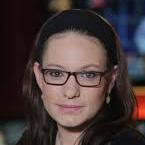
WE OFFER A MIXED ENVIRONMENT FOR RELIGIOUS AND SECULAR, FOR NEW IMMIGRANTS AND NATIVE ISRAELIS
SOCIAL & CULTURAL ACTIVITIES
Nofei Yerushalayim has a variety of interesting social & cultural activities. Both in English and Hebrew
MEDICAL CARE
Nofei Yerushalayim provides residents with 24 hour medical care and supervision. There is also a nursing wing in the building
ENTRY PROGRAMS:
There are a number of options which are tailored to the needs and financial abilities of each potential resident: Monthly rental, Single Payment Entry Fee or Deposit
Come visit us or call for further information: 02-675-1311

Last time we explained that in the sad case of baby Sofia, born to a couple who are not her genetic parents, even if the father or mother were disqualified from marrying due to their halachic status, this would not disadvantage the child. Based on this we claimed that there is no need to continue to find the genetic parents.
However, we could make a different claim, that a person is obligated to know who their parents are. The verse (Bemidbar 1:18) instructs Moshe to “gather together the entire congregation on the first day of the second month and they will bear children by their families according to the houses of their fathers”. Rashi explains that Moshe was able to count them and gather them by family since “each one brought the record of their lineage and witnesses of their birth in order to prove their connection with their tribe.”
Rabbi Yitzchak Zilberstein (Chishukei Chemed, Eruvin 73a) was asked by a young woman who was adopted whether she should search for her biological parents. Even though she has immense gratitude to the wonderful couple who adopted her, she still feels a need to find out who her biological parents were.
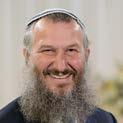
Rabbi Zilberstein thought that she should
look for them, based on the above verse and Rashi’s explanation. A person should know which “tribe” they belong to, where they came from and who their parents are. He asked his late brother-in-law, Rabbi Chaim Kanievsky, who disagreed.
Rabbi Kanievsky explained Rashi a little differently; there is no obligation on a person to know exactly which tribe they emanate from, indeed, today, except for Leviim and Cohanim, no one knows the identity of their tribe. Rather, a person needs to know that their parents are Jewish and their halachic status.
If the adopted woman knows that her parents were Jewish and there is no halachic barrier to her marrying a Jew this is sufficient. There is no halachic reason to know the exact identity of her parents.
In another discussion (ibid. Berachot 35b), Rabbi Zilberstein suggests that a person must find out who their parents are in order to fulfill the obligations of honoring one’s parents. But the late Rabbi Steinman disagreed, and explained that since the mitzvah of honoring one’s parents is so difficult to keep one is not obligated to go out of their way to find out who their biological parents are.
In the case of baby Sofia, since we are not concerned that her parents’ status will impact her ability to marry, it appears that there is no obligation to continue to search for her biological parents.
More on this next time.

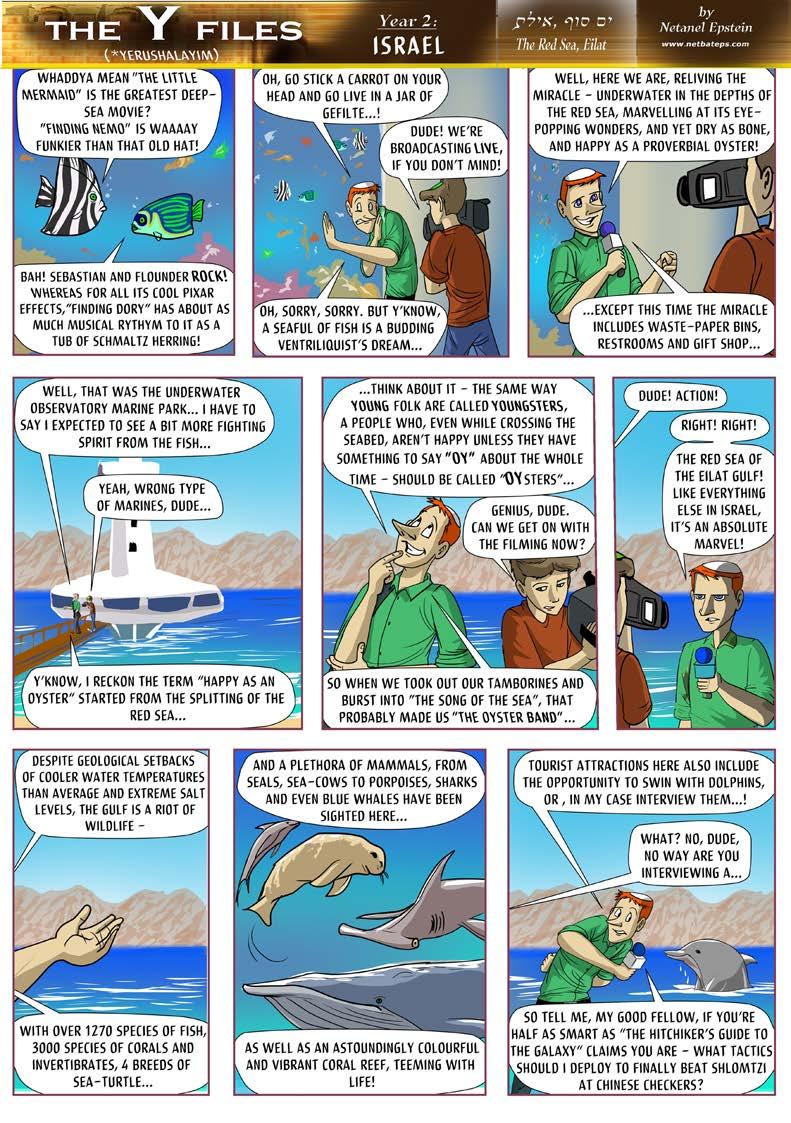
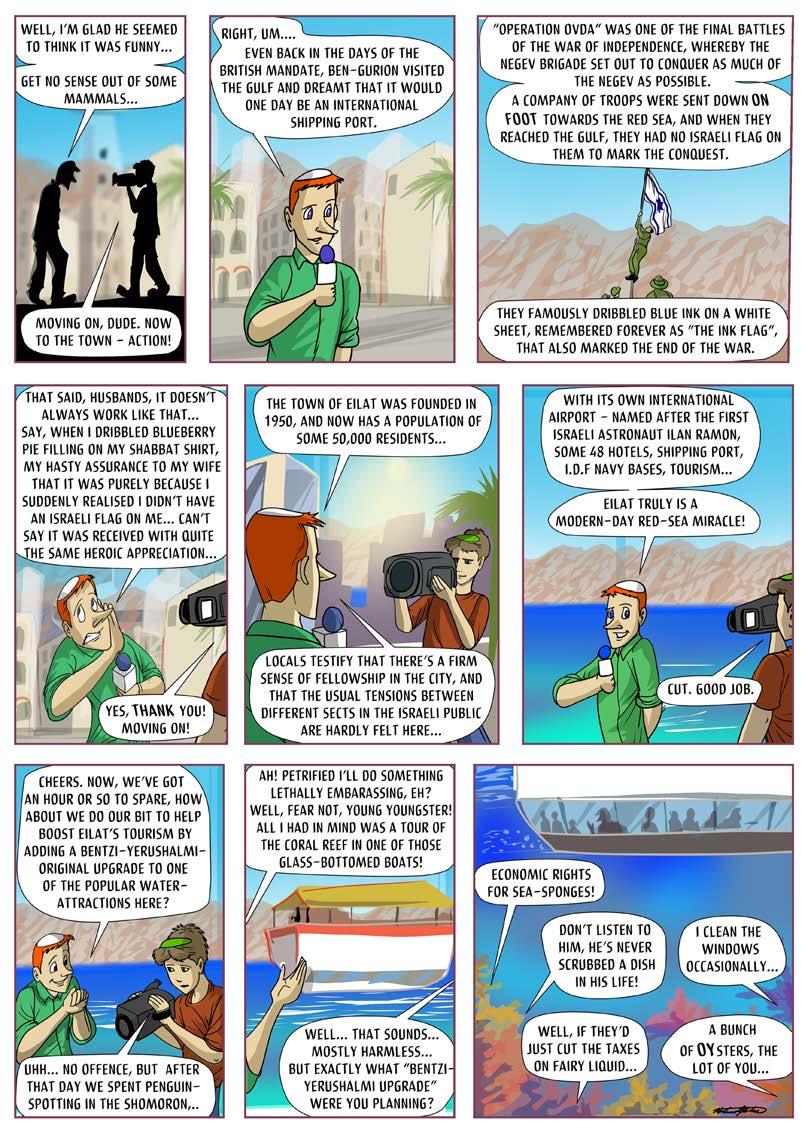

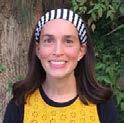
Rabbi Avraham Dov Auerbach of Avrush served as a Rebbe in the Ukraine during the 1800’s. When he was in his 60’s, he finally fulfilled his life-long dream of moving to Eretz Yisrael. Back in the Ukraine, he had heard all about the beauty of Eretz Yisrael, and how even the stones in the street shine like diamonds. He was so excited to finally arrive at his destination. But when he got to Israel and settled in the city of Tzfat, he didn’t see beauty. All he saw was desolation and hardship. He was so depressed he even considered returning to his hometown of Avrush. He couldn’t understand why he could not tap into the beauty of Eretz Yisrael. Finally, someone explained to him that in order to see the beauty, you need to be worthy of it. Rav Avraham Dov secluded himself for a year, during which time he worked on himself and was eventually able to recognize the kedusha found in every stone of Eretz Yisrael.
Though this story took place 200 years ago, I believe we can all relate to it on some level. We arrive in Israel expecting the kedusha to jump out at us, and it doesn’t. Personally, I remember my first visit to the Kotel and feeling disappointed and let down. Making aliya
can be challenging and exhausting and sometimes those feelings get in the way of feeling any sort of spirituality. But that doesn’t mean it isn’t there!!
We will soon see how this story is specifically connected to Tu b’Shvat and the bracha of Al Hamichya.
With the approach of Tu b’Shvat, we will take a break from our analysis of Birchat HaMazon and instead focus this week on the special bracha of Al Hamichya, which we recite numerous times each day after we eat mezonot or any of the shivat haminim (the 7 special fruits which Israel is specifically praised for). In this bracha, we recognize and thank Hashem for all of the sustenance He has given us. We go on to thank Hashem for bringing us into Eretz Yisrael in order that we could eat its fruits.
For the precious, good, and spacious land which You have graciously given as a heritage to our ancestors, in order to eat of its fruit and to be satiated with its goodness.
The Bach (Orach Chaim 208) quotes some opinions that say that we should skip this part of Al hamichya! After all, how can we thank Hashem for bringing us to Eretz Yisrael for something so petty as the fruit – that’s not why we want to be here! Who
cares about the fruit? Is there really any difference between an apple in Israel and an apple in America?! The Bach however argues vehemently with these opinions and says as follows -
Eretz Yisrael is imbibed with a special kedusha which stems from the fact that the Shechina (Hashem’s Presence) resides here. The fruit of Israel sucks up this kedusha from the Land. We don’t realize the unique privilege we have to live here in Eretz Yisrael and to eat the fruit of the Land. An apple here is not the same as an American apple and an Israeli orange is not the same as an American one. Not only in taste and size, but in its actual potential for kedusha! The Bach explains that we praise Hashem for this every day because yes, one of the main reasons we want to be here in Israel is to eat the fruit of Eretz Yisrael, because inherent within it is the unique capacity and potential for kedusha.
We, like Rabbi Avraham Dov Auerbach of Avrush, sometimes fail to see the special beauty and kedusha found in something as mundane as an Israeli apple. We might even complain about its size or its taste, and compare it to what we used to have back in America. But this line in Al Hamichya teaches us to think otherwise.
We find a similar message within the holiday of Tu bShvat. The Magen Avraham brings down that there is a special minhag to eat fruit on Tu bshvat. This is based on the Tikun Yissaschar who says we should especially eat the shivat haminim, and other fruits from Eretz Yisrael. The Sefer Pri Etz Hadar brings down that R’ Chaim Vital used to try and eat at least 30 different types of fruits every Tu b’Shvat!

Why? One reason brought down by Rav Kook in Orot HaKodesh is similar to what we discussed earlier. Rav Kook explains that we eat a lot of fruit on Tu bShvat so that we can sanctify the mundane. (רמוחה) שודק. We have the ability on Tu bShvat, and really throughout the year, to bring out the special kedusha inherent in our fruits. When we take a bite, we need to not only take a moment to appreciate the taste, smell, and feel of the fruit, but to also realize that we are eating a fruit that has soaked up the special kedusha of the Land where the Shechina resides.
To conclude, when you buy your Tu b’Shvat fruit this year, don’t search for those dried apricots and banana chips imported from Turkey. Rather, head over to the fresh produce and buy yourself some nice juicy kedusha-filled Jaffa oranges and thank Hashem for bringing you to this Land in order to be able to הבוטמ עבשלו הירפמ לוכאל, imbibing that kedusha in every bite that you take!!

For students across Israel, these weeks mark the end of the first semester of the school year after our kids (hopefully) have been studying for a range of exams and working to finish up projects and assignments. As the report cards emerge, we have an opportunity to think about how we, as olim parents, relate to our kid’s school performance. Of course, each family will have unique perspectives on grades, depending on their own values and their child’s unique needs. But there may be some similarities that many olim families experience, and it can be worthwhile giving them some thought. Notably, I am not focusing here on situations where kids need evaluations or additional resources at school, or other very relevant topics.
One aspect to reflect on is the timeframe for measuring success. For myself, one of the most frustrating experiences as a parent making aliyah was children’s backpedaling of knowledge. In the United States, they would come home with detailed parasha sheets, and even at a young age, they were able to discuss the parasha at the Shabbat table. When we got to Israel, however, the kids understood so little of what was going on in school that they were unaware that there was such a thing as a parashat hashavua! In other subjects as well, as hard as they might study, they simply were unable to match the scores that they had in the
United States. Had we measured the success of our aliyah by those first weeks and months, we would have been very disappointed, and our kids would have felt the pressure. But viewing the timeframe of measuring success differently, in terms of years, allows for parents to be patient and encouraging toward their child, and for both parents and children to feel less pressure about something they cannot control.

A second aspect to consider is non-academic features of school, especially if you observe that something is not clicking for them. Thankfully, my children have not experienced bullying in their schools, and their schools seem receptive to concerns from parents. But from conversations with parents in various schools, many children do experience bullying, and not all schools are committed to tackling this issue. Using a discussion about the report card as a “foot in the door” to speak about other concerns in school can give parents a valuable window into their child’s life, and alert them to any more significant concerns that their child may have.
Finally, many parents wonder how they can be both motivating and patient toward their child at the same time. From my perspective, this begins with open communication with a few components. First, it is important for parents to clearly express a validating message about how difficult school can be for their kid, especially as it is in a new language. Second, parents can ask
their child in a genuine and open way about their experience in school, which will provide the parents with a better understanding of where they can push a little harder, and when they need to be patient; parents can also make clear to their child that they will be there alongside them to help them succeed in whatever ways they can. A final part of the conversation may also include parents acknowledging that the child will get lower scores, and that over time, with sustained effort, the scores will improve. Telling a moti vated student that scores don’t matter, in an attempt to be compassionate, can be invali dating; instead, try to acknowledge that doing well is important to him/her, and that if he/ she keeps at it, they will begin to see the ben efits of hard work over the coming months.
It can also be incredibly validating and motivating for the child to see parents
working hard to acclimate as well. For example, if a child sees his parent poring over a Hebrew-language newspaper article, trying to understand the words, put together sentences, and even asking for help, it can be easier for him to internalize the value of pushing through difficult things.
As with other areas of life, working to find that right balance between patience and motivation will help our children best navigate the challenges of school.
Dr. Ethan Eisen, PhD is a Licensed Clinical Psychologist (Israel and U.S.) offering Evi dence-Based Solutions for Individuals and






























































Feel free to send in any parenting questions you may have to parenting@ouisrael.org changed to preserve anonymity).























Parashat Beshalach begins with the Israelites fleeing Egypt, only to be pursued by the Egyptians at the Reed Sea. G-d performs a miracle, dividing the Sea, however the Israelites are once again faced with war from Amalek.

Rabbi Lord Jonathan Sacks observes that though we essentially witness the same act of war twice in this parasha, there is one significant difference. In the first, with the Egyptians, it is performed by G-d alone, with G-d Himself fighting for Israel, and in the second, against Amalek, through a partnership between G-d and human beings, with Israel fighting for G-d, demonstrating a transformation within the nation of Israel. Only once Israel fights their own battles do they begin to acknowledge and appreciate G-d.
As human beings, we are defined by our ability to choose. G-d, and Judaism as
a whole, instills within us the importance of being able to fight battles ourselves; not to be dependent, but rather to exercise choice and courage. Parashat Beshalach teaches us that there comes a time when we must accept responsibility for our actions, where we must dedicate serious thought to the choices that we make, and recognize that - with G-d always on our side - we too must invest effort, in order not only for our aspirations to be realized, but to truly embody what it means to live in the image of G-d.
The OU’s Jewish Learning Initiative on Campus (JLIC) is creating and nurturing vibrant religious communities in Israel to support English-speaking college students and young professionals. JLIC Israel’s goals include: building a warm and welcoming Jewish community for students and young professionals; providing engaging and dynamic Jewish education; providing a supportive home environment for Olim; providing resources for personal and religious growth, including personal mentoring, Aliyah support, religious guidance and leadership development. Current JLIC programs in Israel include: Reichman University - Herzliya; Bar Ilan University - Givat Shmuel; Tel Aviv University; Tel Aviv for Young Professionals; and Jerusalem. Contact: Rabbi Jonathan Shulman, Director of OU-JLIC in Israel shulmanj@ou.org


02 678 65 95
5 ROOM APT FOR SALE IN THE GERMAN COLONY
4 bedrooms, renovated , 130 sqm, sukkah balcony, 2nd fl, parking , storage

The Destiny Foundation and RABBI BEREL WEIN
Invite you to three separate events

Sunday Night April 16 at 8:00 PM at Pelech Girls School (Yehuda 31, Baka)

Premiere of the new Destiny film ABARBANEL: A MAN OF MANY WORLDS
Sunday Night April 23 at 8:00 PM
See the film “ABARBANEL” in your home on Zoom in case you cannot get to the physical premiere April 16

A DESTINY SHAVUOT RETREAT AT THE LAVI HOTEL

5 days, 4 nights May 24-28 with RABBI WEIN & other Rabbis. (HashgachaMehadrinRabbanutGalilTachton) For information and to register, send your email address to nachum@jewishdestiny.com
4 ROOM APT FOR SALE IN THE OLD KATAMON

3 bedrooms, brand new , 105 sqm, sukkah balcony, 2nd fl


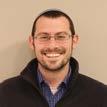
בוט היהת בוט בושחת Pharaoh and his men are approaching Am Yisrael at the Yam Suf and all of a sudden the complaints come pouring in, “Weren’t there enough graves in Mitzraim, didn’t we do tell you when we were slaves to let us be, it would have been better to be slaves in Mitzraim than to die in the Midbar”. Chazal tell us that even as the sea split in front of Am Yisrael, they complained that it was muddy! They said “In Mitzraim we need to make bricks of mud and here we are stuck with our feet in mud”. After the crossing of the Yam Suf, Am Yisrael traveled for three days in the Midbar and could not find water to drink. The Torah then tells us:
He suggests that perhaps it wasn’t that the water was bitter, rather the people were bitter, their attitude was too bitter. A person could be the beneficiary of the greatest miracles and greatest presents but if they have a negative attitude it simply won’t be good enough. If one has a positive outlook on life they will feel a sense of calm and appreciation with whatever they have. Let’s strive to think בוט and God Willing we will see the בוט in our lives.

This weeks Parsha is Parashat Beshalach. As is known, we the Jewish people, came out of Egypt and eventually made our way to the land of Israel.
“They came to Mara and they could not drink the water because it was bitter..”
The Kotzker Rebbe (Menachem Mendel Morgensztern of Kotzk: 1787-1859) explains that happiness is a function of attitude, many people always see the positive and also, some people always see the negative.
Mazal Tov to Shai & Leah Rubin on the Bar Mitzvah of their son, Asher
It seems from these pesukim that Bnei Yisrael would rather have been slaves than soldiers.
Sometimes in life, when one is facing a difficulty or challenge, it seems impossible. When one is at the bottom of a small hill, it can sometimes seem like a mountain.
Even though slavery is worse than war, in the eyes of Bnei Yisrael approaching war, it seemed like an impossible challenge.
Therefore, Hashem sent them to the Midbar after Egypt, in order to take a step back and see the bigger picture and be able to appreciate the amazing land that we were given.
Sometimes we have to step back to understand that the challenge is doable and worth it.
After all our nation went through we have to understand and be able to make decisions for the things that matter most. Sometimes we get scared, lazy, angry, etc, but at the end of the day just like how the Jews got to the Holy Land, we too can overcome obstacles that to us seem impossible.
I hope you all have an amazing and meaningful Shabbos.

• Miriam Tovah Chaya bat
Chanah Elisheva Rivka
•Yosef Ezriel ben Chaya Michal
הלחמ ןב ןתנוהי •
רתסא ןב המלש •
לזייר הניס ןב ץרה ילתפנ •
הכרב הנח ןב השנמ םהרבא •
• Esther Fruma bat Baila
• Yisrael Leib ben Chana
Special properties for sale!

>> Off market! Rechavia penthouse!
Luxury finishes, big sukka balcony, elevator parking and storage, 12.5m NIS
>> Nachlat Achim amazing investment! Selection of new apartments. 4-room apartment starting at 3.3m NIS

>> Talbia new exclusive!




New building 2 apartments left! Has parking, balcony and very high finishes. Price 60000 nis/sqm
>> Rechavia/ Shaarei Chessed! Duplex roof top apartment! Bright 4 room duplex with massive roof top and parking! 4.8 m nis
>> Unique renovated 4 room apartment on the first floor, balconies (one sukka) and storage! 6.5 m. Nis flex
